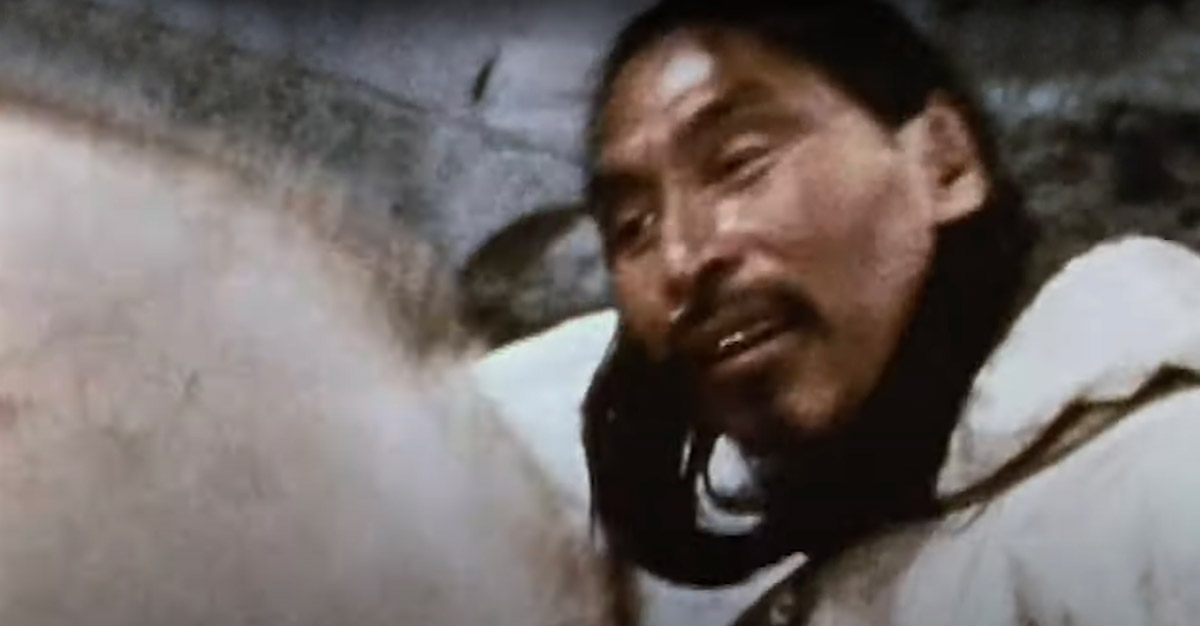
Chronology
Milestone Events & Influences
1963
Martin Charles Firrell is born on 4 April 1963 suddenly and unexpectedly on the pavement outside 70-72 Avenue des Champs Élysées, Paris France.
1966-71
His early state education in the UK is progressive in line with educational theory of the times. Less emphasis is placed on reading, for example, and greater emphasis on creative play, allowing the creative faculties to mature first. He does not read until the age of nine.
Netsilik Inuit from the experimental curriculum
Man: a Course of Study
b1974.1
1972
He is taken to the newly opened Odeon Anglia Square after much debate about whether or not the 8-year-old will be frightened of the dark. The opposite turns out to be true and he is moved by the beauty of the modernist auditorium, the immense curved and upward-tilted screen, and the overwhelming scale of the moving image. This visit marks the beginning of a lifelong interest in material presented in public space at scale.
Odeon Cinema, Anglia Square Norwich
b1972.1
1973
Sees
Hello Dali,
an award-winning documentary in which presenter Russell Harty spends several days in the company of Salvador Dalí.
NOTE
Salvador Domingo Felipe Jacinto Dalí i Domènech, Marquess of Dalí of Púbol (1904 – 1989) was a Spanish surrealist artist renowned for his technical skill and striking dream-inspired images in his work. Born in Figueres in Catalonia, Dalí received his formal education in Fine Arts in Madrid. Influenced by Impressionism and the Renaissance masters from a young age, he became increasingly attracted to Cubism and the avant-garde. He moved closer to Surrealism in the late 1920s and joined the Surrealist group in 1929, becoming one of its leading exponents.
'Although I was only ten years old at the time, this glimpse into the life of an artist stayed with me for the rest of my life.'
Film still,
Hello Dali,
Dir. Bruce Gowers, LWT 1973
b1973.1
1974-75
He is part of a cohort of children following the experimental one-year curriculum
MACOS
or
Man: a Course of Study.
The curriculum is introduced into British Schools by The Centre for Applied Research in Education at the University of East Anglia.
MACOS is an American humanities teaching program based on the theories of educationalist Jerome Bruner.
NOTE
Jerome Seymour Bruner (1915 – 2016) was an American psychologist who made significant contributions to human cognitive psychology and cognitive learning theory in educational psychology. In 1960, he published
The Process of Education
in which he wrote, 'knowing how something is put together is worth a thousand facts about it.' Bruner became involved in the design and implementation of
Man: A Course of Study
or
MACOS
which sought to produce a comprehensive curriculum informed by the latest developments in the behavioural sciences. It was Bruner's belief that 'any subject can be taught effectively in some intellectually honest form to any child at any age of development'.
Bruner believed it was possible to teach children what it meant to be a human being (and to mitigate racism and ethnocentrism in the process) by studying the lifecycles of other animals and the way of life in other cultures. Bruner advocated a 'spiral curriculum' in which a concept is taught repeatedly at intervals, each reiteration of the concept more sophisticated than its predecessor. This process of 'revisiting' enables the child to assimilate and form a relationship with increasingly complex ideas over time.
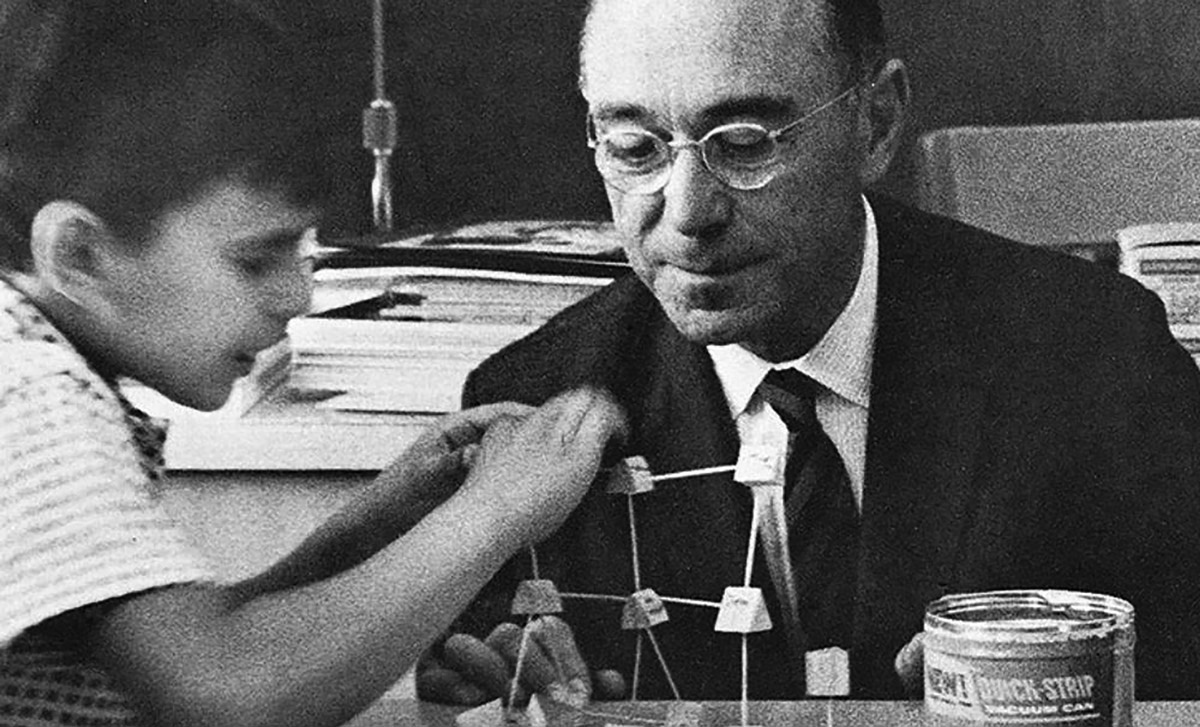
Jerome S. Bruner 1915-2016
b1974.2
MACOS
focuses on 'the chain of life', exploring the lifecycles of the Pacific Coast salmon, the herring gull, the baboon (particularly within the societal context of the baboon troop) and ultimately, Cananda's Netsilik Inuit.
MACOS
relied on films to reveal and illuminate the contents of the course. The documentary material about the Netsilik way of life (and the interaction between the Netsilik and other life forms, such as reindeer and seals) remains a landmark in visual anthropology.
MACOS
exerts a profound influence on Firrell, fostering an appreciation of the natural world, a grasp of the interconnectedness of all life, and respect for people who are different, or lives that are lived differently.
The artist has gone so far as to say that his entire art practice can be regarded as a sustained and extended extemporisation on ideas gifted to him by the
MACOS
curriculum.
1975
John Hurt plays Quentin Crisp in the TV drama
The Naked Civil Servant.
NOTE
Quentin Crisp (born Denis Charles Pratt, 1908-1999) was an English writer, performer, raconteur and wit. One of 'Britain's Stately Homos', he was the author of many books important to the artist:
The Naked Civil Servant
(1968),
How To Become a Virgin
(1981),
The Wit and Wisdom of Quentin Crisp
(1984),
Resident Alien
(1996) and
The Last Word
(2017).
The Naked Civil Servant
was the basis of a 1975 made-for-television biographical comedy-drama film adapted by Philip Mackie, directed by Jack Gold, and produced by Verity Lambert with John Hurt in the role of Crisp. It was produced by Thames Television and originally broadcast on 17 December 1975 on the British channel ITV.
Firrell is ridiculed at school as a ‘Quentin', which has the effect of marginalising him as ‘other’. This fuels his indignation at injustice
per se
and kindles feelings of kinship with anyone who is misunderstood or excluded. These feelings will be carried into the artist's mature work.
'I always want to be loved for being so far out. I suppose because I was hated at school for being so far out. I want my revenge.'
A number of teaching staff express homophobic views, ridiculing the artist with homophobic slurs like ‘pink pants’ and on one occasion, ‘sugar plum fairy’. The artist’s response is to pirouette around the classroom singing as the other children stand silently to attention at their desks. Firrell remembers this as a pivotal moment of defiance and visibility, claiming, rather than denying his LGBT+ identity. His refusal to submit to ridicule has a curious effect on both the teacher and the class. The teacher does not know how to react and so does nothing. Her inaction, in turn, reveals to the rest of the class that power no longer lies in her hands but has been seized by the pupil.
1977
His education at secondary level is more conventional and he stops going to school at age 14 because he 'has no more use for it'. Instead, he reads the complete works of Virgina Woolf.
NOTE
Adeline Virginia Woolf, née Stephen, (1882 – 1941) was an English novelist, critic and feminist writer. She is considered one of the most important modernist authors of the 20th Century. She pioneered a 'stream of consciousness' approach to narrative in which the naturalistic, fleeting impressions experienced by her characters, take the place of traditional plot.
Woolf's novel
Orlando
(Hogarth Press, 1928) brings her love affair with Vita Sackville-West into sharp focus and is the first in a long line of realisations about the immense cultural importance and historic impact of LGBT+ voices. He walks in the Norfolk countryside, swims in the North Sea and experiments with amateur super 8 filmmaking.
1980
Clare Short appears on television frequently in the early 1980s.
NOTE
Clare Short (born 1946) began her career as a civil servant. She was Member of Parliament for Birmingham Ladywood from 1983 to 2010 and served as Secretary of State for International Development from 1997 to 2003. She resigned from the cabinet in protest against the Iraq War. She resigned the party whip in 2006 and served the remainder of her term as an independent politician.
'Though I was very young, I had the impression that the only person speaking the truth - however inconvenient that might be - was Clare Short. And she was speaking truth to power in a brave and emphatic way. She and Peter Tatchell
NOTE
Peter Gary Tatchell (born 25 January 1952) is an Australian-born British human rights campaigner, best known for a lifetime of campaigning for LGBT+ rights around the world.
were disliked in our household because they were thought of as 'trouble-makers' and that made me like them both even more.'
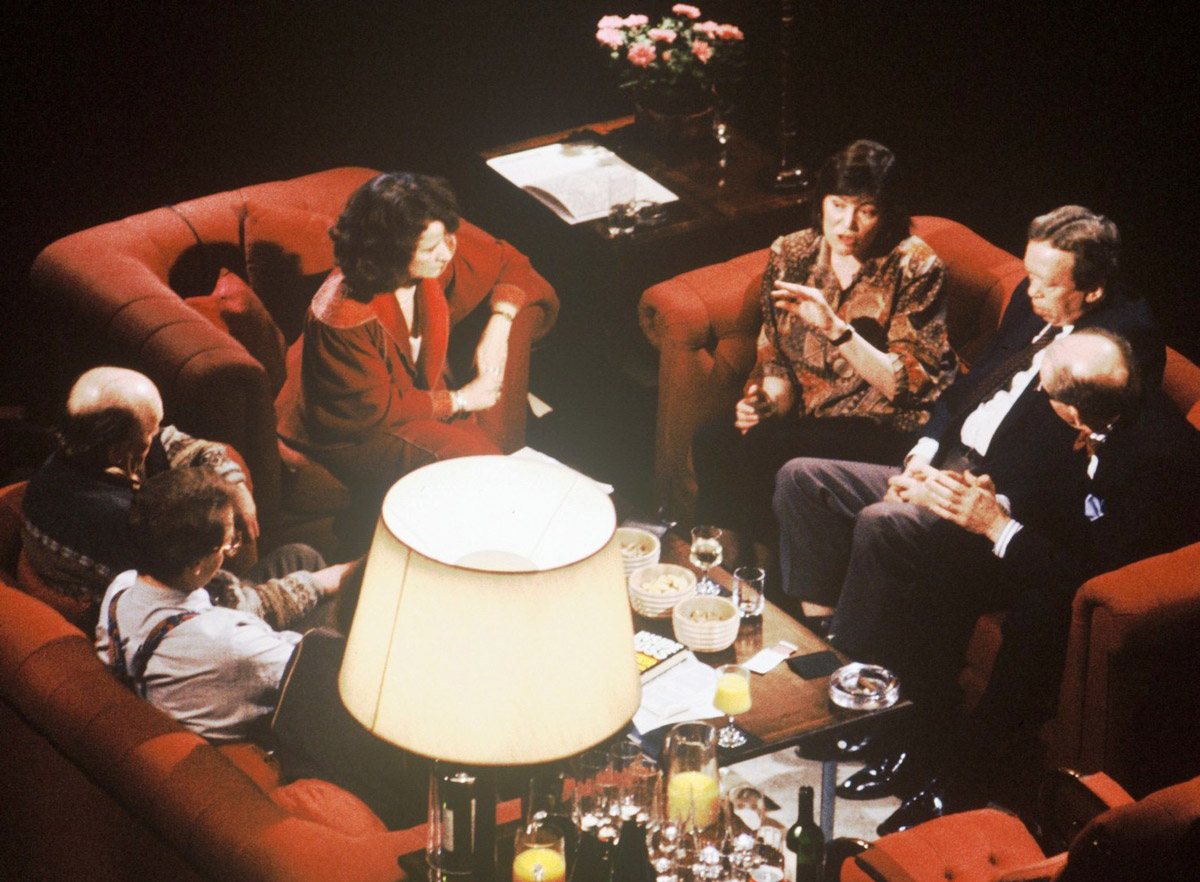
Clare Short (b. 1946) on
After Dark
(Channel 4) 'Counting the Cost of a Free Press', 1991
b1991.2
1981-82
Enrolls in the one-year vocational course,
Advertising Writing
at Watford College of Art and Design. Meets fellow student Pat Doherty (later Boles), who becomes lifelong friend and confidante.
1982-83
First job as an advertising copyrighter at Crawfords Advertising Agency, one of the most important British advertising agencies of the 20th century. Senior Art Director Ashley Havinden championed modernist typography and a visual style influenced by cubism, futurism and The Bauhaus. These visual innovations formed the foundation of the agency's progressive reputation.
Spends every Thursday evening at the Camden Palace: 'We danced to German techno, I saw my first 'gender-bender', we had no money, we stayed out all night with just enough money for a minicab home (there was no night tube) and then did a full day at work. We experimented with new music, new looks, clothes made of rubbish. I super-glued joke hair into my own to create a permanent false dreadlock. We listened to, and loved, Divine. Grace Jones did a very short live set, then gave us all the finger and walked off. Boy George was just another punter.'
1984-1990
Works as an advertising copywriter at American advertising agency, Grey, in London. Creates
The Goalmouth Juventus
and
Runner
both with art director, Mark Currie, both for Nike.
The Goalmouth Juventus
(with Mark Currie), Nike, 1987
b1987.1a
Runner
(with Mark Currie), Nike, 1987
b1987.2
While still working in advertising, embarks on a reading programme of early Modernist writers. This includes the poetry of Edith Sitwell
NOTE
Dame Edith Louisa Sitwell DBE (1887 – 1964) was a British poet and critic. She published poetry continuously from 1913, some of it abstract and set to music, most notably in
Façade
(1922), a series of abstract poems set by William Walton.
Façade
was performed behind a curtain with a hole in the mouth of a face painted by John Piper; the words were recited through the hole with the aid of a megaphone.
and the complete works of novelist Denton Welch
NOTE
Maurice Denton Welch (1915 – 1948) was a British writer and painter. At the age of 20, he was hit by a car while cycling in Surrey and suffered a fractured spine. Despite his injuries, he continued to paint and, perhaps because of them, he started to write. In August 1942, he wrote an essay on the painter Walter Sickert which, published originally in
Horizon,
brought him to the attention of Edith Sitwell. The majority of Welch's output was published posthumously: an unfinished autobiographical novel
A Voice Through a Cloud
in 1950; a further short story collection,
A Last Sheaf,
in 1951;
The Denton Welch Journals in 1952;
an unfinished travelogue,
I Left My Grandfather's House
in 1958; and a poetry collection,
Dumb Instrument,
in 1976.
including
Maiden Voyage,
and
The Journals of Denton Welch
(both copies inscribed '1988' by the artist on their title pages). Reading Sitwell inevitably leads to
Façade
and composer William Walton
NOTE
Sir William Turner Walton OM (1902 – 1983) was an English composer. He wrote music in several classical genres and styles, from film scores to opera. His best-known works include
Façade,
the cantata
Belshazzar's Feast,
his
Viola Concerto,
his
First Symphony,
and the British coronation marches
Crown Imperial
and
Orb and Sceptre.
and subsequently to
Portsmouth Point
(1925), a favourite because of its associations with Englishness and the Sea.
Discovers the predominantly autobiographical fiction of Marguerite Duras.
NOTE
Marguerite Germaine Marie Donnadieu (1914 – 1996), known as Marguerite Duras, was a French novelist, playwright, screenwriter, essayist, and experimental filmmaker. She was the author of many novels, plays, films, interviews, essays, and works of short fiction, including her best-selling, highly fictionalized autobiographical work
L'Amant
(1984), translated into English as
The Lover,
which describes her youthful affair with a Chinese-Vietnamese man. The novel was awarded the Prix Goncourt in 1984.
In November 1990 reads
Blue Eyes Black Hair
and
La Douleur.
Is influenced by Duras's use of language as a simple, declarative tool, often in combination with subtle repetitions.
1991-1992
Reads Duras's
Emily L.
Encounters the life and work of Gertrude Stein.
NOTE
Gertrude Stein (1874 – 1946) was an American novelist, poet, playwright, and art collector. Born in Allegheny, Pennsylvania (now part of Pittsburgh), and raised in Oakland, California, Stein moved to Paris in 1903, and made France her home for the remainder of her life. She hosted a Paris salon, where leading figures of modernism in literature and art, such as Pablo Picasso, Ernest Hemingway, F. Scott Fitzgerald, Sinclair Lewis, Ezra Pound, Sherwood Anderson and Henri Matisse, would meet. In 1933, Stein published a quasi-memoir of her Paris years,
The Autobiography of Alice B. Toklas,
written in the voice of Alice B. Toklas, her life partner. The book became a literary bestseller and made Stein a household name. Her stream-of-consciousness experiments, rhythmical essays or 'portraits', were designed to evoke 'the excitingness of pure being' and can be seen as literature versions of art movements like Cubism, plasticity, and collage. Many of the experimental works such as
Tender Buttons
have since been interpreted by critics as a feminist reworking of patriarchal language. Despite Stein's work on We automatic writing with William James, she did not see her work as automatic, but as an 'excess of consciousness'. Though Stein collected cubist paintings, especially those of Picasso, the largest influence on her literary work was the work of Cézanne. Particularly, he influenced her idea of equality, distinguished from universality: 'the whole field of the canvas is important'. Rather than a figure/ground relationship, Stein used the entire text as a field in which every element mattered as much as any other. Stein explained: 'The important thing... is that you must have deep down as the deepest thing in you a sense of equality.'
‘I admired her courage, her work, her unapologetic lesbianism, her marriage to Alice B. Toklas, and her masculinity. She was my mirror image, a masculine woman to my feminine man. She defied gender. She defied definitions of all kinds. She forged boldly ahead. And she inspired me, in my own way, to do the same.’
Stein will go on to become the artist's creative magnetic north.
'I learned from Stein that the profound value in anything lies not in what it is, but in the intensity with which it is what it is.
'And as I walked in the park listening to Philip Glass
NOTE
Philip Glass (born 1937) is an American composer and pianist. He is widely regarded as one of the most influential artists of the late 20th Century. His work is built from repetitive phrases and shifting layers of sound, linking it to the Minimalist movement. Glass describes himself as a composer of 'music with repetitive structures'.
I realised this music would be with me for my whole life, and Duras and Stein. And that these were foundation stones on which a fine creative life could be built.'

Gertrude Stein photographed by Carl Van Vechten, New York, 1934
b1991.1
Lectures at the National Portrait Gallery on the life of Lady Ottoline Morrell.
NOTE
Lady Ottoline Violet Anne Morrell (1873 – 1938) was an English aristocrat and society hostess. Her patronage was influential in artistic and intellectual circles, where she befriended writers including Aldous Huxley, Siegfried Sassoon, T. S. Eliot and D. H. Lawrence, and artists including Mark Gertler, Dora Carrington and Gilbert Spencer.
Further lectures are commissioned: on the life and work of Virginia Woolf; on modernism and Stein; on the Sitwells, including a recital of several poems from
Façade
declaimed through papier-mâché megaphones made by the artist (performed with fellow Sitwell admirer, Cathy Lauzon, now Maddoc-Jones).
A passage from
The Four-Chambered Heart
(1950) by Anaïs Nin
NOTE
Angela Anaïs Juana Antolina Rosa Edelmira Nin y Culmell (February 1903 – 1977) was a French-born American diarist and author. Six volumes of her journals have been published:
Henry and June, Fire, Incest, Nearer the Moon, Mirages,
and
Trapeze.
In addition, Nin wrote several novels, critical studies, essays, short stories, and volumes of erotic literature.
informs his ultimate relationship with language - and with art itself - as something purposeful, which should help us navigate existence:
Words.... eluded all truths, eluded essentials, eluded the bare demon in human beings, and added to the blindness, added to the errors. Novels promising experience, and then remaining on the periphery, reporting only the semblance, the illusions, the costumes, and the falsities, opening no wells, preparing no one for the crises, the pitfalls, the wars, and the traps of human life. Teaching nothing, revealing nothing....
He underlines the impact of this passage in a later journal entry:
There is a clear ethical element to enabling as many people as possible, from as many walks of life as possible, to have access to ideas that will help them live well. That was the lesson of
The Four-Chambered Heart
and I could have found those lessens elsewhere but I happened to be looking at fiction.
Leaves advertising and a sustained period of experimental writing begins. Reads the novels of poet Stevie Smith:
NOTE
Florence Margaret Smith (1902 – 1971), known as Stevie Smith, was an English poet and novelist. She won the Cholmondeley Award and was awarded the Queen's Gold Medal for Poetry. A play,
Stevie
by Hugh Whitemore, based on her life, was adapted into a highly-regarded film starring Glenda Jackson.
Novel on Yellow Paper
(Jonathan Cape, 1936),
Over the Frontier
(Jonathan Cape,1938) and
The Holiday
(Chapman and Hall, 1949).
Invites Smith's biographer, Frances Spalding, to tea to discuss Smith's seemingly eratic prose and the creation of her alter-ego Pompey Casmilus.
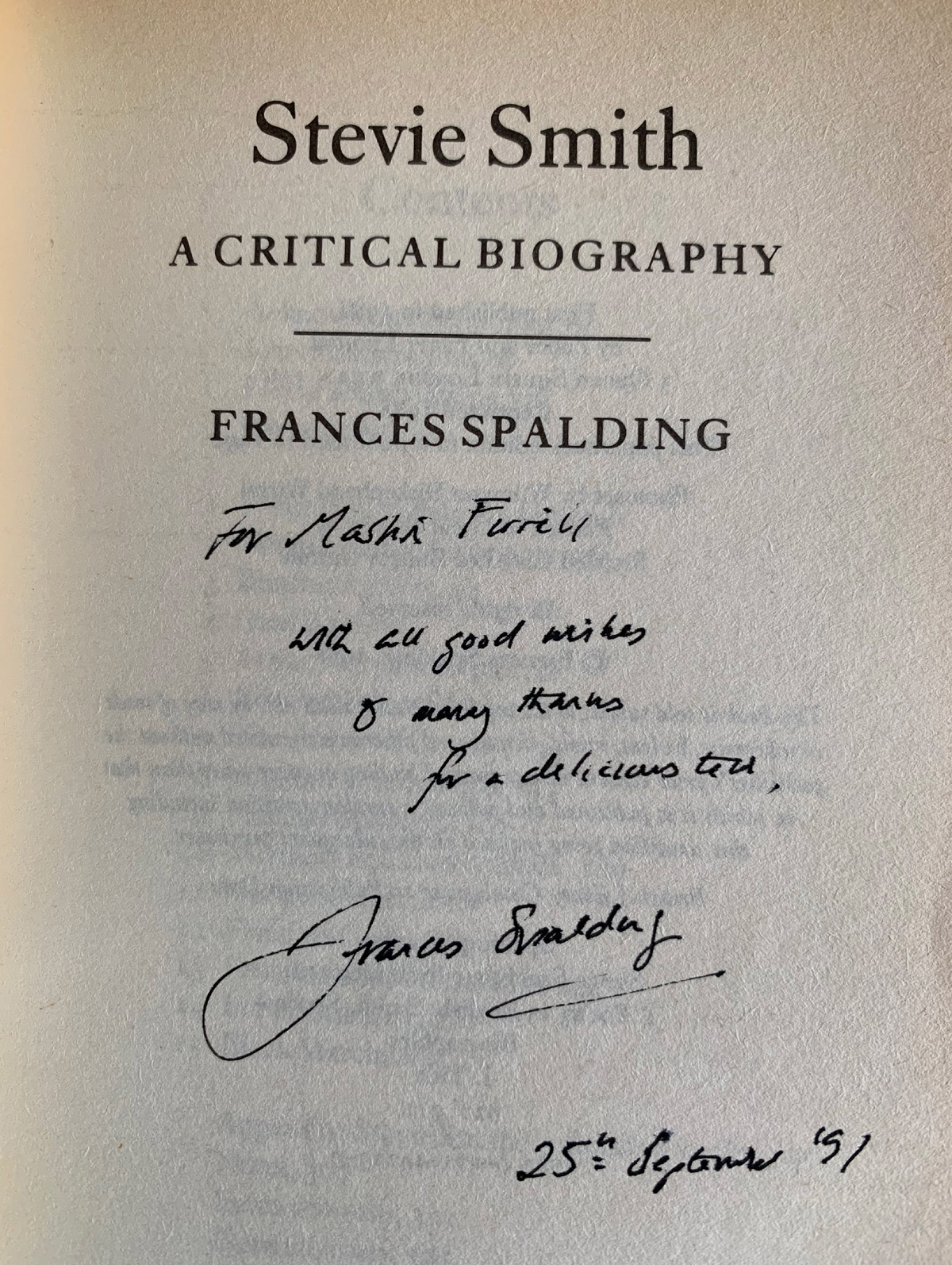
Title page of
Stevie Smith, a Critical Biography,
by Frances Spalding (Faber & Faber, 1990), inscribed by the author to the artist.
b1991.3
Publishes the experimental novella
The Beautiful and the Grave
and the longform prose narrative
Anyone Can Swim
(both Providence Press, 1992).
1993-1995
Visits painter Langham Bailey (b. 1956; his sister) at her home in Suffolk and sits for a portrait to mark his 30th birthday. This painting, of all material possessions, becomes the most prized. The image has been variously interpreted as a crucification - the artist as tortured figure - or as a depiction of ecstasy/transfiguration. He favours the second interpretation, referring to the intense 'bliss' or 'white heat' of the act of creating something 'wrought out of nothing'. He describes his visit in contemporary and later journal entries:
The weekend when I was ill and lay under LB’s tree by the pond and she talked to me, and put crystals around me... and then the walk along the beach, talking, and the heat, and the boys with the bongos and still light at 9.30pm, and she swam and I walked and the sea with the last of the sun over it like a golden slick... and I realised I had never seen it get dark at the beach before. Years later she said in that moment on the beach, she was entirely happy, entirely in the moment, free... together we went somewhere. It was a moment in both our lives that marked or changed things.
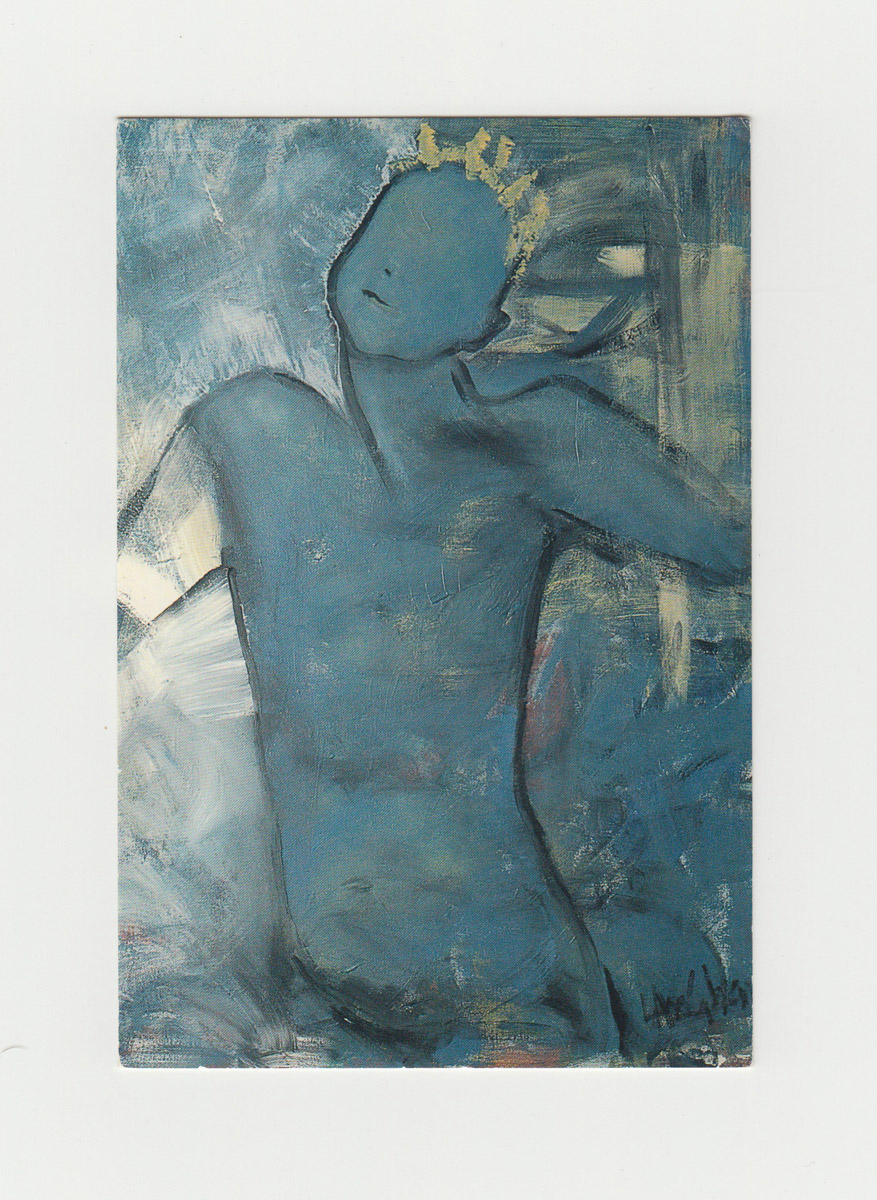
Langham Bailey,
Portrait of Martin Firrell,
1993. Acrylic on canvas, 108 x 138cm.
b1993.2
Begins work on many iterations of an artist’s manifesto inspired by Tristan Tzara's Dada-ist texts,
NOTE
Tristan Tzara, Romanian: born Samuel or Samy Rosenstock, also known as S. Samyro (1896 - 1963) was a Romanian avant-garde poet, essayist and performance artist. Also active as a journalist, playwright, literary and art critic, composer and film director, he was known best for being one of the founders and central figures of the anti-establishment Dada movement.
Marinetti's manifesto of Futurism
NOTE
Filippo Tommaso Emilio Marinetti (1876 – 1944) was an Italian poet, editor, art theorist, and founder of the Futurist movement. He was associated with the utopian and Symbolist artistic and literary community Abbaye de Créteil between 1907 and 1908. Marinetti is best known as the author of the
Manifesto of Futurism,
written and published in 1909. Futurism rejected the past and celebrated speed, machinery, violence, youth, and industry. The manifesto also advocated for the modernization and cultural rejuvenation of Italy.
and André Breton's writing on Surrealism.
NOTE
André Robert Breton (1896 – 1966) was a French writer and poet, the co-founder, leader, and principal theorist of surrealism. His writings include the first Surrealist Manifesto (
Manifeste du surréalisme
) of 1924, in which he defined surrealism as 'pure psychic automatism'.Breton is also the author of celebrated texts such as
Nadja
and
L'Amour fou.
These works, combined with his critical and theoretical texts on writing and the plastic arts, made André Breton a major figure in 20th-century French art and literature.
Meets Russian pianist Yekaterina Lebedeva (b.1968) who encourages these theoretical explorations.
Throwing back the door to find Katya in an extravagant hat! A great success of a hat like an inverted, brimmed flowerpot. The new look, new all over again.

Yekaterina Lebedeva, Cafe aux Deux Magots, Paris France, April 1998
b1998.3
Lebedeva will go on to translate the completed manifesto into Russian and arrange for its distribution at the Literaturnoye Kafe in St. Petersburg. Different drafts take many forms but the central endeavour remains the same - to identify an expressive form that can be said to be irrefutably sound:
The life of ideas is the loneliest, most austere province on earth. In the life of our own ideas we are most imprisoned and most at liberty at one and the same time. We can elect to abandon our own concern for the quotidian world by absolute decree (ceremonial paper lanterns blaze with light: green-lipped mussels, a butterfly, a giant locust) but we cannot know the life of one another’s ideas or be made to feel one another’s acts of abandonment anymore than we can ever wholly know ourselves. Life is not sensible. Sense, meaning, organisation are not helpful. Freedom from concern is an intuitive, impulsive, irrational, absurd “discovery” we must each make for ourselves like the discovery that silk handkerchiefs are derived from grubs.
The moment we become concerned with the details and techniques of expression we begin to have a wrong understanding of it.
But when we abandon all concern, the doors of perception clang open and mystery runs silently in. In mystery’s wake, the heaven-sent flotsam of an incomprehensible certainty: 'I am absolutely certain that I do not know what I am looking at'; (the green-lipped mussel opens to reveal a horse). Absolute expression seems to give no outward sign (it is always sealed inside the life of ideas) but by the purity of our intention to abandon our concern, to honour absence, inaction and undisturbed space, by the purity of our intention, we act or pass through the lives of ideas of everyone else.
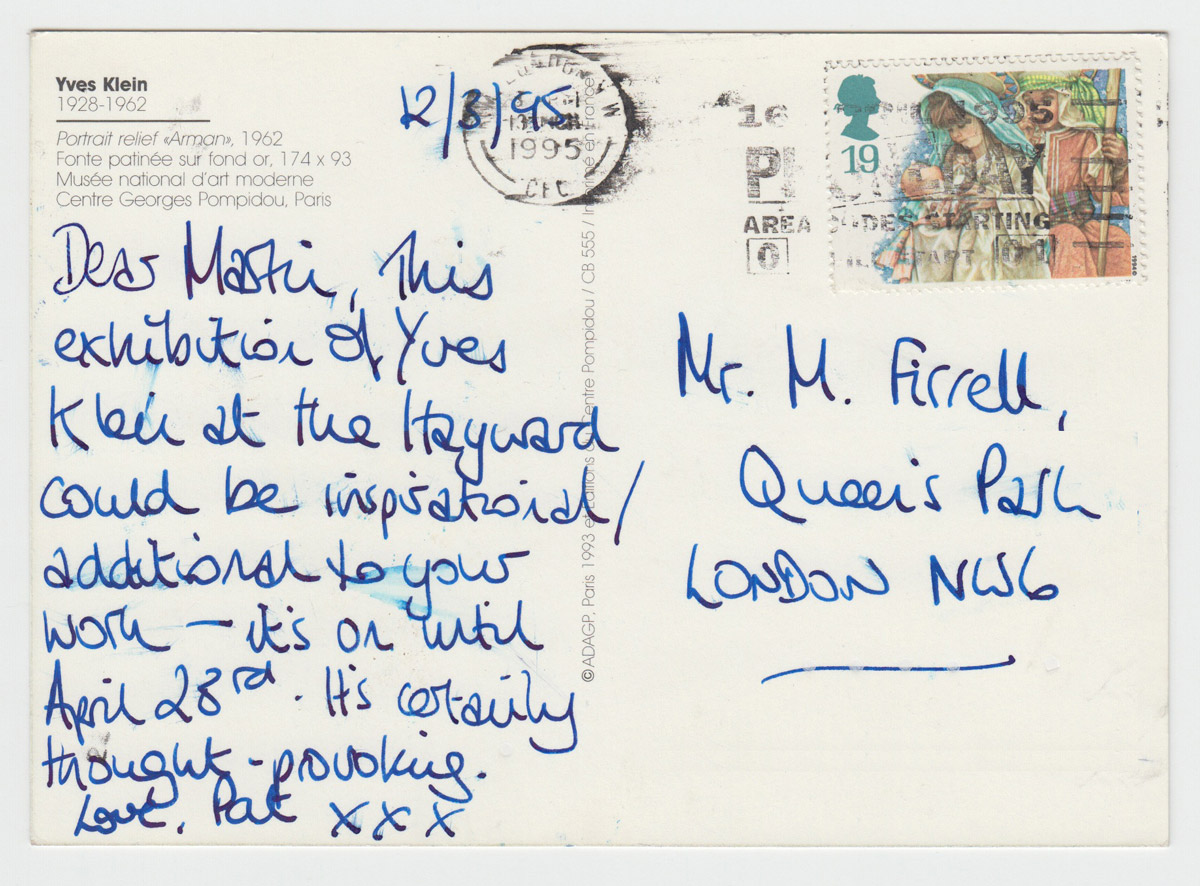
Postcard from Pat Doherty to the artist, 1995
b1995.1
Sees
Yves Klein
at the Hayward Gallery (9 February-23 April 1995)
NOTE
Yves Klein (1928 – 1962) was a French artist and an important figure in post-war European art. He was a leading member of the French artistic movement, Nouveau réalisme, founded in 1960 by art critic Pierre Restany. Klein was a pioneer in the development of performance art, and is known for the creation of International Klein Blue, blue pigment applied without the use of medium to preserve the velvety intensity of its colour.
on the recommendation of Pat Doherty. Klein's interest in the void and non-ness suggests a new field of exploration which finds its way into the manifesto writing.
Visits Capri and spends days writing in the
Giardini di Augusto
with views over the
Marina Piccola
. Discovers Steve Reich's
Accoustic Counterpoint
and
Electric Counterpoint
NOTE
Stephen Michael Reich, known as Steve Reich, (born 1936) is an American composer and pioneer of minimal music. Reich's work is marked by its use of repetitive figures, slow harmonic rhythm, and canons. Reich describes this concept in his essay
Music as a Gradual Process:
'I am interested in perceptible processes. I want to be able to hear the process happening throughout the sounding music.' For example, his early works experiment with phase shifting, in which one or more repeated phrases plays slower or faster than the others, causing it to move slowly out of phase. This creates new musical patterns in a perceptible flow.
and this music becomes an enduring source of inspiration. The lyric writing created on Capri is important and formative, reappearing in slightly different variants in future works such as
The Question Mark Inside,
2008
(2008.2)
.
Long heated-up afternoons above the sea at Capri, walking from the Via Tragara to the Villa Krupp (was it Gorky’s villa?), walking in airless contemplation of what next, hope, more than a little love and the sea, as if bluer than God intended, blown out from the island a thousand feet below.
Reads Ernest Hemingway's
Across the River and into the Trees
(1950).
NOTE
Ernest Miller Hemingway (1899 – 1961) was an American novelist, short-story writer and journalist. Known for an economical, understated style that influenced later 20th-century writers, he has been romanticized for his adventurous lifestyle and outspoken public persona. Many of his works have become classics of American literature. He was awarded the Nobel Prize for Literature in 1954.
Firrell is struck by the Venetian mise en scene, the novel's pervasive wistfulness and the Colonel's International Herald Tribune folded neatly on his bedside table (Firrell will go on to become the International Herald Tribune's, Cultural Attaché in London). Though a favourite of the artist's, this was the first of Hemingway's novels to receive negative press on its publication in 1950.
1996
Visits Cambridge for the first time and is chauffeured along the river Cam by a PhD student called Steve.
Spends the summer on Blakeney Point, a large shingle spit on the North Norfolk coast. (Will later buy a fisherman's cottage in North Norfolk near Blakeney.) The summer is particularly fine and the landscape, and most especially the sea, finds its way into the experimental writing of the time:
Seen from a very great distance, the surf does not break. Never seen before, there would be no sensation of the waves sitting up. Distance diminishes the surf to a scattering of points which open, thicken, famine, die away.
Collapse and telescope the distance-reduced sea, the running tide, the estuary, the beach, the terns, nesting grounds, shingle, walking, swimming, drying stretched out over the sharp points of flint.
He must have known the way to walk the flats, between the samphire and the twisted lines of the creeks, across the estuary to the point. Rucksack swaying from one brown shoulder. Alive. Unhurrying. Passing the last of the dunes before the sea. Mud caked and drying already against his legs.
A tempered language to give the whole of the intention with the least possible distortion.
One. Brown. Shoulder. Unweighted. The sun still hot, the sea, the blown-paper gulls.

Blakeney Point by the artist, facing west, 1996.
b1996.1
The years of reading and experimental writing culminate in the publication of the artist's manifesto,
Lucid Between Bouts of Sanity
(1996.1)
in a tri-lingual edition - English-Russian-French - at the ICA in London and the Literaturnoye Kafe in St Petersburg Russia (with the support of Lebedeva).
'I have just learned that Marguerite Duras has died. She was alcoholic, treated for it three times; ruthlessly, painfully honest, ruined, ruinous, complex, a huge life, great. I’ll accept no smaller life.
Lucid Between Bouts of Sanity
was translated into French for her...'
The year closes with an oddly elegaic journal entry dated 6.12.96:
A strange nostalgia, a feeling for a few years ago, something connected with the countryside, Walton, a naivete I suppose - a sort of ‘freshness of hope’ (did I write about Steve the Ph. D.’s freshness for the world?) for myself and for the work, for life, for kinships. Is it significant that the feeling should return now? Perhaps it is to do with being on the edge of something new. And the hope is the hope of imminent discovery...

Lucid Between Bouts of Sanity,
1996
1996.1
The text of
Lucid Between Bouts of Sanity
explores the reductive nature of action, the flaws in language, the difficulty of meaning anything accurately to anyone, and the possibility of using a constrained and reduced language to find a new expressive power.
Although brief, it is a structured review of the expressive means available to any artist whose work is founded on language. It can be seen as the attempt to describe the limits within which all language must operate and so designates a clearly defined space for the experimentation that will follow.
Lucid Between Bouts of Sanity
reaches its climax in a series of statements that are self-supporting, suggesting that the artist is trying to establish a firm footing for the work to come. For example,
It Is Impossible To Set Foot on an Uninhabited Shore
is undeniably true and, in the artist’s view, constitutes a ‘cast-iron sentence’ on which it's possible to build with confidence.
1997
Berg and Schoenberg at the Festival Hall on Friday. I saw that I have studied literature under Gertrude Stein and music under Webern et al. Journal entry: 28.9.97.
NOTE
Arnold Schoenberg or Schönberg (1874 – 13 July) was an Austrian and American composer, music theorist, teacher and writer. He was among the first modernists to transform the practice of harmony in 20th-century classical music. He went on to develop the most influential form of twelve-tone technique or serialism. This technique was taken up by many of his students, who constituted the so-called Second Viennese School. They included Anton Webern (1883 - 1945), Alban Berg (1885 - 1935), and Hanns Eisler (1898 - 1962).
And then the day was stolen away by chores (although I did see the recital at St John’s, Smiths Square of Schoenberg, Webern, Berg... O such courage and such cause for faith...)
Journal entry: 24.11.97.
Reads
The Creative Mind
by French philosopher, Henri Bergson;
NOTE
Henri-Louis Bergson (1859 – 1941) was an influential French philosopher. Bergson argued that processes of immediate experience and intuition are more helpful than abstract rationalism and science in understanding reality.
Giacomo Joyce,
a brief prose work by James Joyce;
NOTE
James Augustine Aloysius Joyce (1882 – 1941) was an Irish novelist, poet and literary critic. He contributed to the modernist avant-garde movement and is regarded as one of the most influential and important writers of the 20th Century.
Giacomo Joyce
was published posthumously by Faber and Faber from sixteen handwritten pages by Joyce. The text is a free-form love poem that tracks the waxing and waning of Joyce's infatuation with one of his students in Trieste. The original manuscript contains fifty fragments transcribed onto eight large sheets of sketching paper. It was written in Joyce's "best calligraphic hand". The text is quoted at length in Richard Ellmann's 1959 biography
James Joyce
but wasn't published in its entirety until 1968.
and
Worstward Ho
by Samuel Beckett.
NOTE
Samuel Barclay Beckett (1906 – 1989) was an Irish-born existentialist writer of novels, plays, short stories and poems. His literary and theatrical work features bleak, impersonal, and tragicomic experiences of life, often coupled with black comedy and nonsense. His work became increasingly minimalist as his career progressed, involving more aesthetic and linguistic experimentation, with techniques of stream of consciousness, repetition, and self-reference. He is considered one of the last modernist writers.
Worstward Ho,
written in English in 1983, is Beckett's penultimate novella. Its title is a parody of Charles Kingsley's 1855 historical novel
Westward Ho!
and includes Beckett's famous lines: 'Ever tried. Ever failed. No matter. Try again. Fail again. Fail better.'
These influences inspire his attempts to use language in new ways under the governance of intuition rather than logic.
Lunches with Quentin Crisp in New York City. This meeting, recorded in a contemporary journal entry, provides pivotal creative inspiration both personal and professional:
I flew to New York to have lunch with Quentin Crisp at his local diner, The Cooper Square Restaurant on the corner of E5th street and 2nd Avenue. 1pm. 2 November 1997.
The diner was plain from the outside - plate glass and dark wood - and plainer still on the inside - bare wooden tables and chairs. I arrived before Quentin, and two enormously tall men in white aprons, who seemed as capable of murder as cooking, washing up, or waiting tables, looked me up and down to ensure I was ‘alright’ to meet ‘Mr Crisp'.
I must have passed the test because they showed me to a table and offered me a beer while I waited. I had read
How To Become a Virgin
with Quentin's claim, 'All I have to offer the world is my availability'. He pointed out that he was listed in the Manhattan phone book under 'C'.
I had looked up the number in the directory in my hotel room and he had answered with a theatrical 'Oh yes...'
Now suddenly here he was, smaller than I had expected and very lovely, very beautifully got up with mauve hair under a wide-brimmed hat, light make up, wonderfully scented, wearing a pale silk shirt.
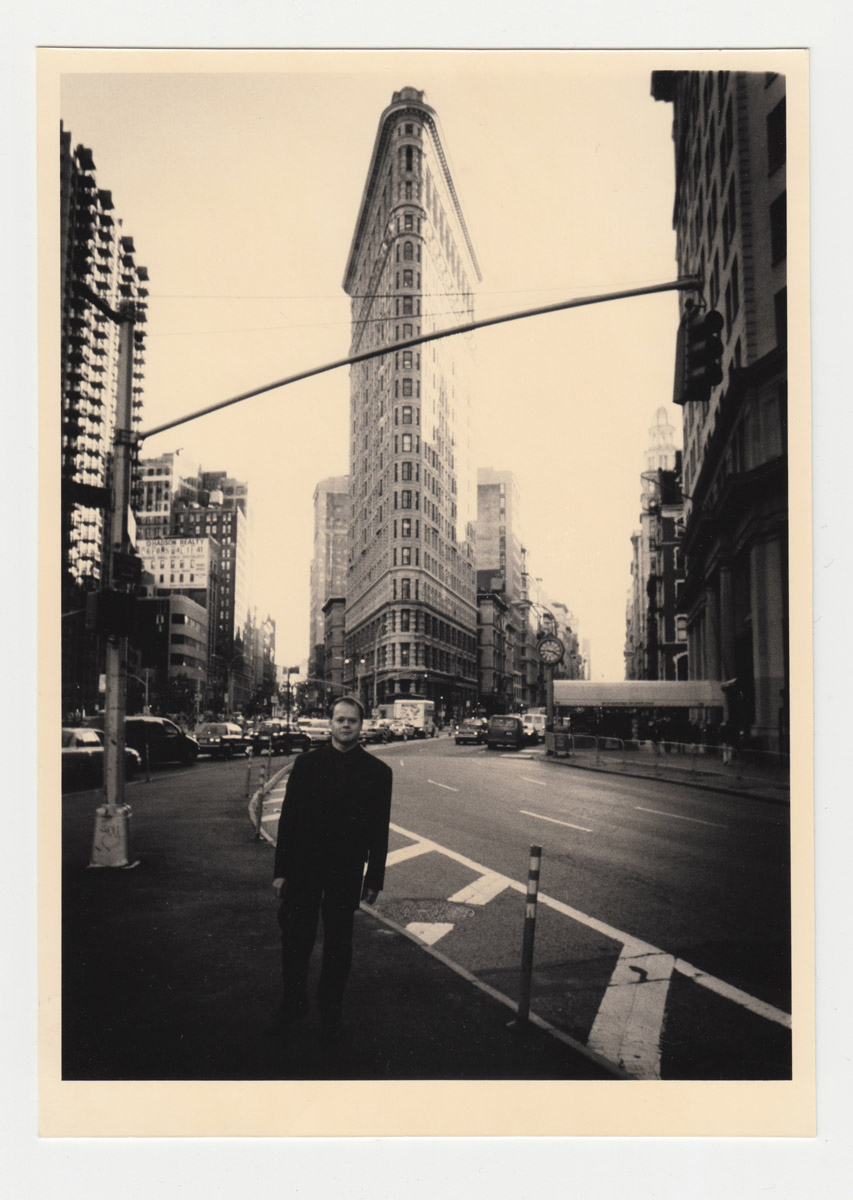
The artist and the Flatiron building, 175 Fifth Ave NYC, October or November 1997
b1997.2
Quentin had loomed large in my imagination since my school days as a beautiful idea and now here he was as a man.
He talked about New York as 'heaven on earth' and the old movie stars 'Miss Dietrich' and 'Miss Garbo', and I recognised some of the things he said from the books he had written.
I realised he was 'singing for his supper' or more accurately, 'ranconteuring for his lunch'. I felt delighted and then a little short-changed because he was not meeting me, but performing for me. I wondered if he, too, was nervous, and the performance was a way of overcoming his shyness.
The very tall men approached our table again, not as part of the service I realised, but to check on Quentin. As long as he was smiling they retreated back into the gloom but I have no doubt if he'd been unhappy with the conversation - or me - they would have thrown me out of the diner without thinking twice.
At the time, controversy was surrounding Quentin because of comments he had made in a recent interview. He had, in effect, come out as transgender but the LGBT+ community knew and loved him as a gay icon. I asked him if it were true that he would have been happier if he could have transitioned and run a knitting wool shop in Harrogate.
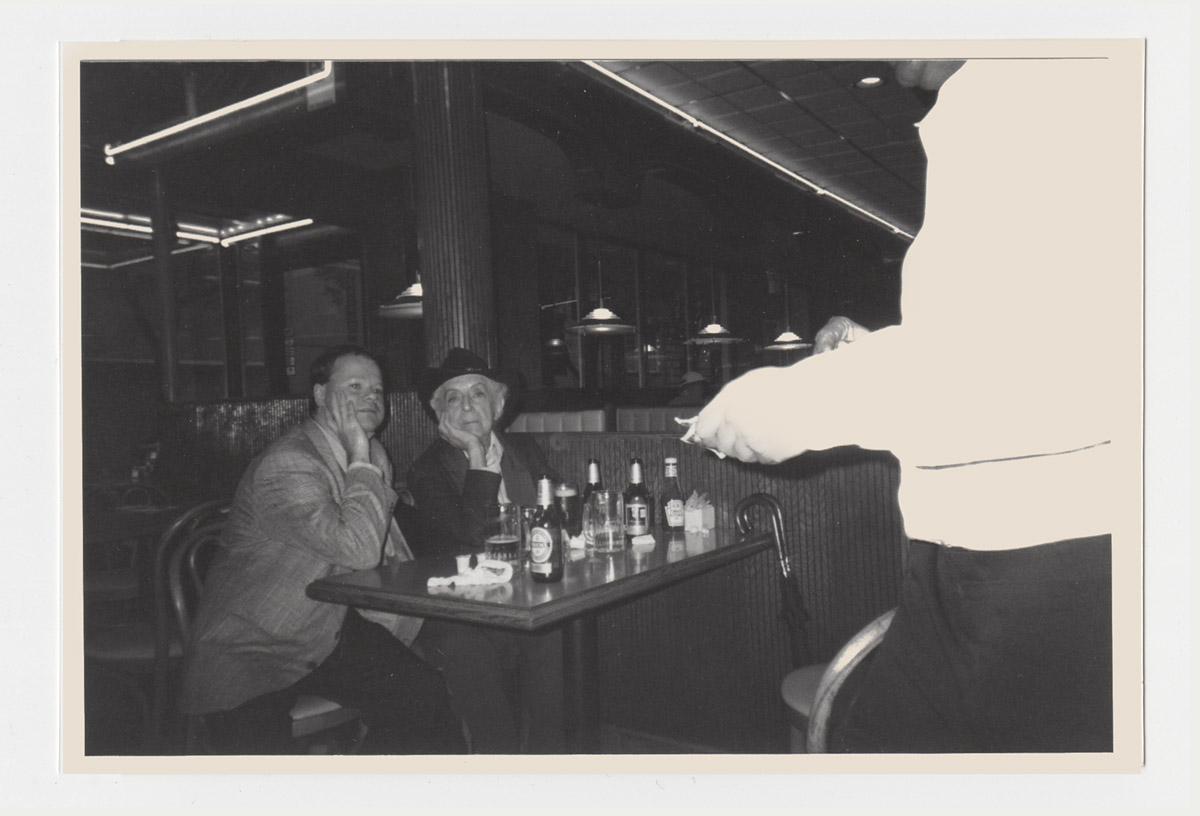
The artist and Quentin Crisp, Cooper Square Restaurant, 2 November 1997
b1997.1
He stopped performing and looked me square in the face and told me it was true. None of it was said for effect. He realised it had disappointed many people but they had made him 'a gay icon', he had done nothing but live his life as truthfully as he could. Now he realised he was not homosexual at all but transgender.
In his final book,
The Last Word,
he wrote: 'If the operation had been available and cheap when I was young, say when I was twenty-five or twenty-six, I would have jumped at the chance. My life would have been much simpler as a result. I would have told nobody. Instead, I would have gone to live in a distant town and run a knitting wool shop and no one would ever have known my secret. I would have joined the real world and it would have been wonderful.'
I could see both sides of the argument. For the community he was a pioneer, living his own truth, and becoming acclaimed, as a gay man, for his courage, wit and imagination.
But I also saw the terrible cost of living as an 'outlaw' as he once described it. The relentlessness of that. The lack of peace.
I was young, in the early part of my career and eager for advice about how to ‘get on’. Quentin told me, ‘Say Yes to everything!’ And later on, in a telephone conversation a few weeks after our lunch: ‘Lean Forward so that Fate Can Catch Sight of You.’
These words meant a great deal to me, and from that time I have tried, insofar as it is possible and legal, to say yes to everything. I have tried to lean forward so that fate can catch sight of me, and the results have not been too shoddy.
To me, Quentin's overriding characteristic was being sure of being right in going on in his own way. Quentin would tell you that it was the only thing he was able to do. But I think there is more to it than that. I believe he had profound courage and self-worth in spite of his comment in
The Last Word,
'I am nobody and nothing'.
As we ate, the sun went down behind the houses on the opposite side of the square. Long shadows in the afternoon and the sky unbelievably empty, bright, cold. Lunch with Quentin expanded my expectation of what life might offer and what I might be able to give to it and take from it.
I realised Quentin had lived so completely without reference to anything else, and had placed himself so completely outside. I grasped the costs of this and the rewards. By comparison, the rest of us live with one eye always on our position in relation to others. We are not independent. Independence is so very difficult to achieve. As Quentin put it, the trick is to 'live your life as if no one else existed'.
1998
Cartwheels across the Pont des Arts in Paris to mark his 35th birthday and the halfway point to the biblical life span of three-score-and-ten years. The cartwheel is encouraged and photographed by Katya Lebedeva.
Cartwheel, Pont des Arts, Paris France, 1998
b1998.1
I wanted to go home to Paris, to stand outside 27 Rue de Fleurus, to be with Gertrude, to make my performance on the Pont des Arts, to celebrate with friends, trained in from London for lunch at Bofinger. It was a great moment of assertion and independence. We walked to La Defense and I saw Takis
Signaux Lumineux
NOTE
Panayiotis Vassilakis (Greek: Παναγιώτης Βασιλάκης; 1925 – 2019), also known as Takis (Greek: Τάκις), was a self-taught Greek artist known for his kinetic sculptures. In 1957, Takis was waiting at a train station and noticed how the lights and energies of the station melded together. This influenced the creation of a series of sculptures,
Signaux (Signals). Signaux
are sculptures made of long thin metal rods that vibrate and bend as wind passes through them, similar to energy caught by radar transmitters. Takis saw these
Signaux
as capturing the energies of the wind and sky. The work
Signaux lumineux
was commissioned in 1990 for the Grande Arche de la Défense, Paris France.
for the first time, and it had both whimsy and somberness which seemed appropriate to the moment, though I am not sure why; perhaps because I was breaking away from an old life and making determined efforts to remake things anew.'
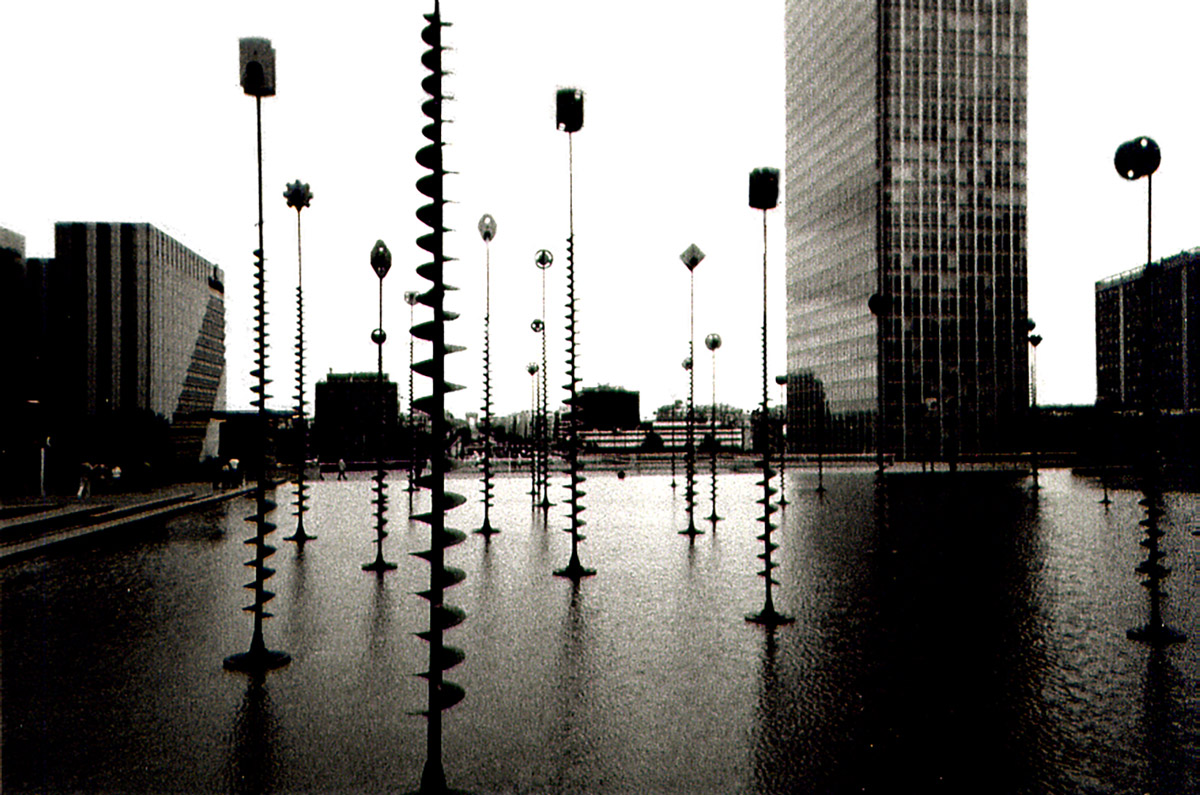
Signaux Lumineux
at La Defence, Paris France, April 1998
b1998.2
Drafts
Postcards 98
at Cafe Laville overlooking the Regent canal in London's Little Venice. Both the cafe and the location appear in the texts. Publishes
Postcards 98,
(1998.3)
his first work conceived expressly for public space.
2000
I must look into the media thing - I’m sure this is the moment for Stevie to help.
Visits Stevie Spring, former colleague at Grey Advertising London, now CEO Clear Channel UK. The meeting takes place at Clear Channel's offices in Golden Square, Soho. Spring offers the artist access to a four-storey experimental screen at 1 Leicester Square London WC2H 7NA, effectively making Clear Channel UK the artist's first corporate patron. This begins a relationship that will span at least four CEOs and continues to the present day.
Stevie has made the screen in Leicester Square possible... and this is tremendous, for whatever I am, I shall be a hundred feet tall. And how lovely Quentin was, how important and inspirational. It’s not so much now about what do I dare to do, but what do I dare not to do.
Glitter Ball, Leicester Square, 2001
2001.2b
2001
Moves to Soho Lofts at 90 Wardour Street. Creates
Untitled (Fly-posters)
(2001.1.1 - 2001.1.3)
. These are his first works for the poster medium: 3 fly-posters for Soho, London UK, heavily influenced by the writing of Marguerite Duras. Breakfasts every day at Maison Bertaux, the legendary French patisserie at 28 Greek Street in Soho owed by sisters Michele and Tania Wade. Becomes unofficial artist in residence.
Untitled (Fly-posters), 2001
2001.1.1
Meets drag queens Jaime/Suzi and Paterno/Desire.
I went to see Desire’s striptease act, and somehow he took everything off and still maintained the illusion. Later he was complaining about not being paid enough for the work he had put in, asking me, 'Have you any idea how long it takes to apply a prosthetic pussy?' My drag queen chums - so beautiful, so mad, like an elaborate rude gesture to Norwich, school, provincialism and bigotry.
The artist, Soho Lofts, 2007
b2007.1
Meets art dealer, Jibby Beane, a larger-than-life theatrical character that appeals to Firrell's sense of the utter.
NOTE
Jibby Beane (birth year unknown) was a fifty-something Surrey housewife until she met fashion designer Vivienne Westwood in the ladies' toilet at the Design & Direction building. Impressed by Beane's energy and style, Westwood invited her to model and, at the age of 51, Jibby joined Kate Moss and Naomi Campbell walking for Westwood on the Paris catwalk. Beane was one of the first gallerists to show work in a domestic space. Her inaurgural exhibition opened in her Bayswater flat in London on 14 July 1993, showing the work of then boyfriend Jonathan Golsan. Beane also hosted an arts club. She described
Jibby's Arts Club
as 'a platform for people to do as they like, whether techno-poetry or an impromptu performance. I don't want it to be predictable'. Of her divorce and transformation from suburban wife and mother to artworld doyen she said, 'I don't want to make it sound easy. It was tough. But life is a gift. We owe it to ourselves to live it to the full.'
Beane is one of the first gallerists to show contemporary art in a domestic space. On turning 60, she celebrated by posing nude for a centrefold in
Bare
magazine (editor, Ilse Crawford; publisher, John Brown Media).
Then Jibby picked me up in her car, and gave me a copy of her centrefold signed, and I had the same infatuated feeling I caught from Jaime/Suzi at L’equipe Anglaise on Saturday - a sort of larger feeling that you can get from these fabulously exotic creatures, or from writing, from art... The thunderbolt of meeting Jibby and Suzi and Desire... Jibby told me, ‘Life’s a stage and I dress up for the performance...’ She went to buy a packet of More menthol cigarettes but didn’t really have enough money and the guy in the shop just said, 'That’s fine Jibby...'
With the support of Stevie Spring, opens first public artwork for a commercial digital billboard,
Celebrate Difference
(2001.2),
a digital animation of simple b&w images of the artist, drag queens Suzi and Desire, and a glitter ball. Text panels, derived from the artist’s journals, punctuate the images.
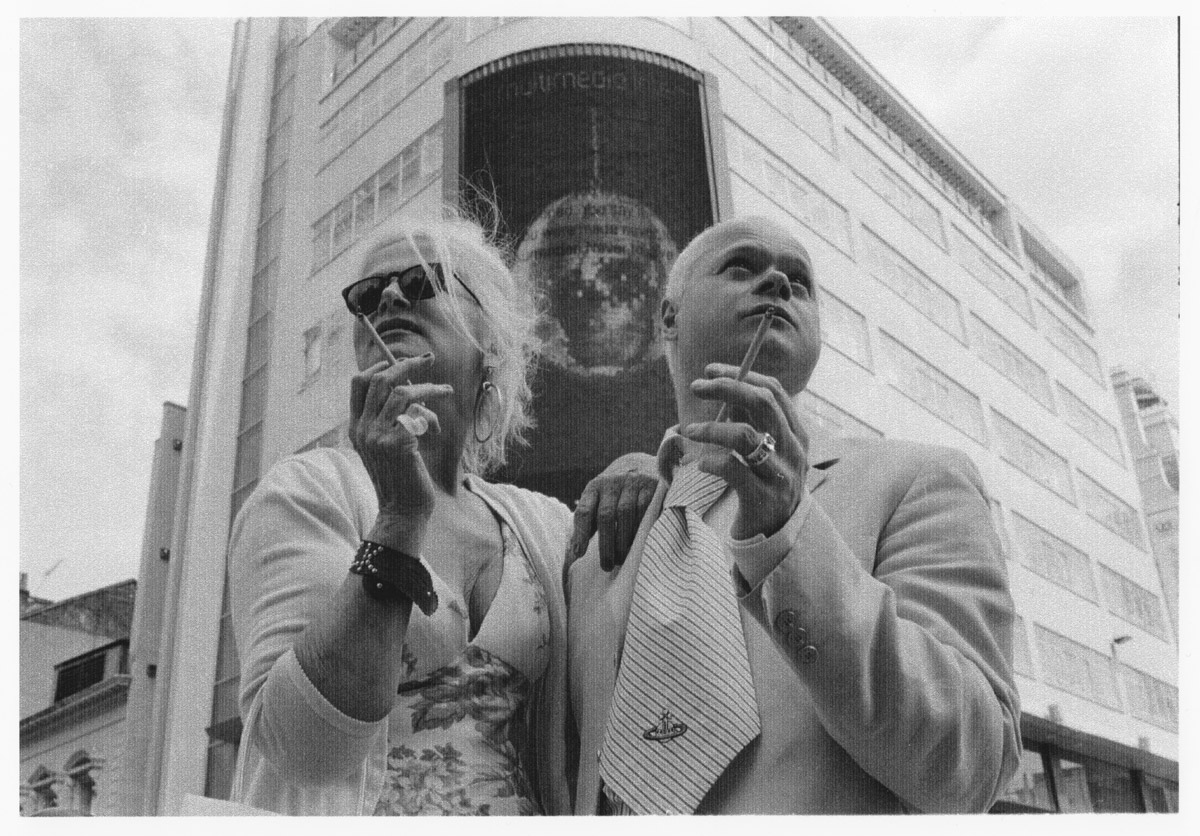
The artist and art dealer Jibby Beane, Leicester Square, 2001 with the artist's work
Celebrate Difference
in the background
b2001.1
Celebrate Difference
is followed by
Instructions for a Happier Life
(2001.3.1 - 2001.3.5)
This work includes the text
Learn to Love Rain,
implying that it is possible to find peace, if not happiness, through the acceptance of what cannot be changed. References to rain recur many times in the artist’s writings around this time:
Wealth of unguessed-at proportions, rain, the sudden coming of rain, the breaking of the season, the season of waiting, broken. Rain. Blown in from the North Atlantic. The first drenching rains of September.
And:
Rain, gloomy afternoons, rain at the windows, a kind of exhaustion. Rain has always been connected in my mind with kindness.
The correlation between rain and kindness, or benevolence, derives from too many unhappy summer holidays in the sun. The failure of the sun to shine correlates with the failure of cruelty in the artist's imagination, and thus rain becomes the antithesis of cruelty.
Learn To Love Rain,
2001 from
Instructions for a Happier Life
2001.3.2
A contemporaneous journal entry underscores the importance of this particular epigram:
It is the apotheosis of what I have been trying to achieve - it is given in simple direct language, it is easy to understand, its meaning goes on for practically ever and it appears in public (in a popular enough form but without compromising the point of it).
2002-2004
Becomes a film voting member of BAFTA, the British Academy of Film and Television Arts. Plans new work with a second billboard company, Maiden Outdoor.
Sees the Lord Berners/Gertrude Stein ballet
A Wedding Bouquet
at the Royal Opera House, Covent Garden.
NOTE
Gerald Hugh Tyrwhitt-Wilson, 14th Baron Berners (1883 - 1950), known as Gerald Tyrwhitt (Lord Berners on inheriting his title) was a British composer, novelist, painter, and aesthete.
A Wedding Bouquet,
1937, was a one act ballet composed by Lord Berners based on the play
They Must. Be Wedded. To Their Wife
by Gertrude Stein. The world premiere took place at the Vic-Wells Ballet in London on 27 April 1937.
Reads and admires the works of novelist Joanne Harris:
NOTE
Joanne Michèle Sylvie Harris OBE FRSL (born 1964) is a British author, best known for her 1999 novel
Chocolat,
adapted into a film of the same name.
Blackberry Wine
(Black Swan, 2000),
Five Quarters of the Orange
(Black Swan 2001), and the work most admired because of its French-island setting,
Coastliners
(Black Swan, 2002).
2005-2006
On 22 July 2005, Jean-Charles De Menezes, a 27-year-old electrician from Brazil, is shot dead by the Metropolitan police. He is mistaken for a terrorist who has tried to bomb London the previous day. De Menezes is shot seven times in the head and once in the shoulder at point-blank range. The artist is appalled and saddened by the murder of the young Brazilian.
Appointed London Cultural Attaché by the International Herald Tribune (now International New York Times). Curates
Breathless,
an arts season supported by the International Herald Tribune.
Shows the projection
All Men Are Dangerous
(2006.1)
at the Duveen Galleries, Tate Britain, commissioned by Amy Lamé and Duckie! The work is a response, at least in part, to wars in Iraq and Afghanistan that were widely regarded as colonially motivated and illegal under international law.
The Guardian commissions a work for its regular Op Art section in which an artist is invited to comment on a contemporary news story. Creates
When the World's Run by Fools It's the Duty of Intelligence To Disobey,
an artist's impression of a large scale projection onto Parliament. This is the artist's first overtly political work, a comment on the government's Religious Hatred Bill, 2006. In two successive votes MPs back House of Lords amendments dramatically narrowing the scope of the proposed law and introducing broad protections for free speech. The published artist's impression is taken as a realised project and further projection commissions follow.
Hears
Music for 18 Musicians
with composer Steve Reich as one of the pianists at the close of
Phases,
the Barbican's encyclopaedic 70th birthday tribute to Reich.
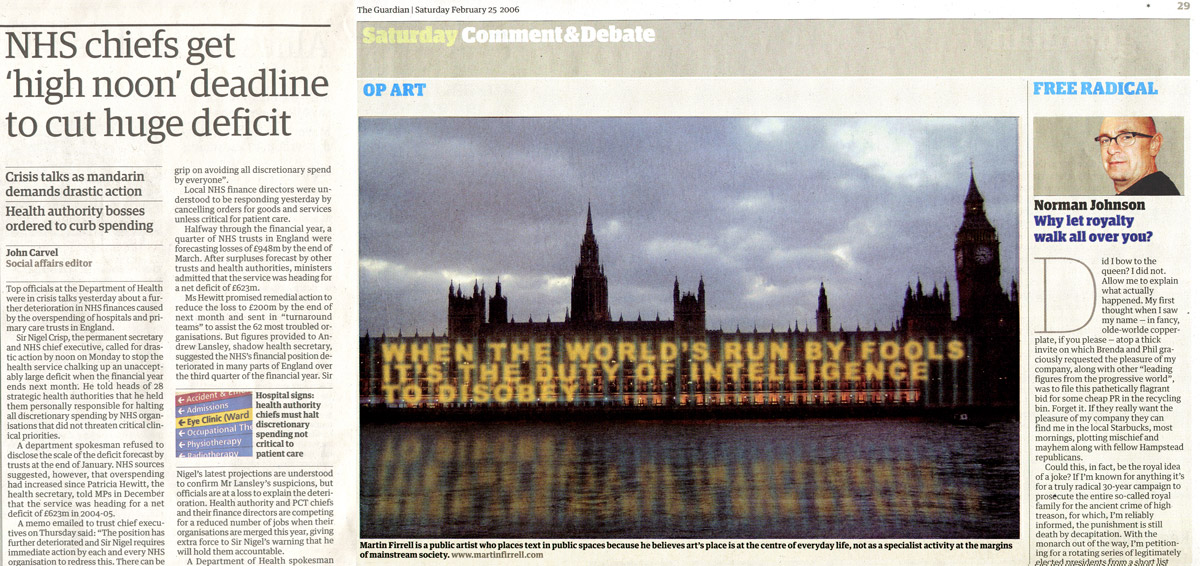
When the World's Run by Fools It's the Duty of Intelligence to Disobey, 2006
u2006.2
Meets Mark Thomas,
NOTE
Mark G. Thomas (born 1964) is a human evolutionary geneticist and Professor of Evolutionary Genetics at the Research Department of Genetics, Evolution and Environment at University College London. In 2009 – in collaboration with Prof Stephen Shennan and Dr Adam Powell – Thomas published a study in the journal
Science
showing that population density and/or migratory activity are likely to be major determinants in the maintenance or loss of culturally inherited skills, and that this seemed to explain a number of curious features of the appearance of behavioural modernity in humans at different times in different parts of the world.
Professor of Evolutionary Genetics at the Research Department of Genetics, Evolution and Environment, University College London. This begins a long and fruitful conversation, which will continue for many years, about art and science, human development and the role of culture.
Meets film producer Simon Channing Williams.
NOTE
Simon Channing Williams (1945 – 2009) was a British film producer. Having worked as a production assistant and television producer in the 1970s and early 80s, he formed the film production company Thin Man Films with Mike Leigh in 1988. This company has produced all of Mike Leigh's films since that time, among them the double Oscar-winning
Topsy-Turvy,
the Oscar-nominated
Vera Drake
and the Palme d'Or-winning
Secrets & Lies.
Then it was time to set off to Don and Hilary’s for dinner just off Charlotte Street - met a lovely fellow called Simon, too, who has just produced 'The Constant Gardener'.
Journal entry: 6.1.06.
Commissioned by the Guardian to make a second Op Art piece. Quotes from his forth-coming projection work for the Trafalgar Square Festival
I Want to Live in a City Where...
(2006.3)
This time the text refers directly to the murder of Jean-Charles de Menezes -
I want to Live in a City Where the Police Don't Shoot You.
The organisers of the Trafalgar Square Festival demand that the text is removed from the artwork and dispatch a security guard to ensure the text is not projected onto the National Gallery.
Inspired by BAFTA shortlisted film
Kinsey,
creates
The One Irreducible Truth About Humanity Is Diversity
(2005.2)
with Maiden Outdoor. Presents the same text in Trafalgar Square, working with Rakesh Dubey of the Indian High Commission to produce a Hindi translation for Diwali. This is the first time Hindi has appeared in Trafalgar Square.
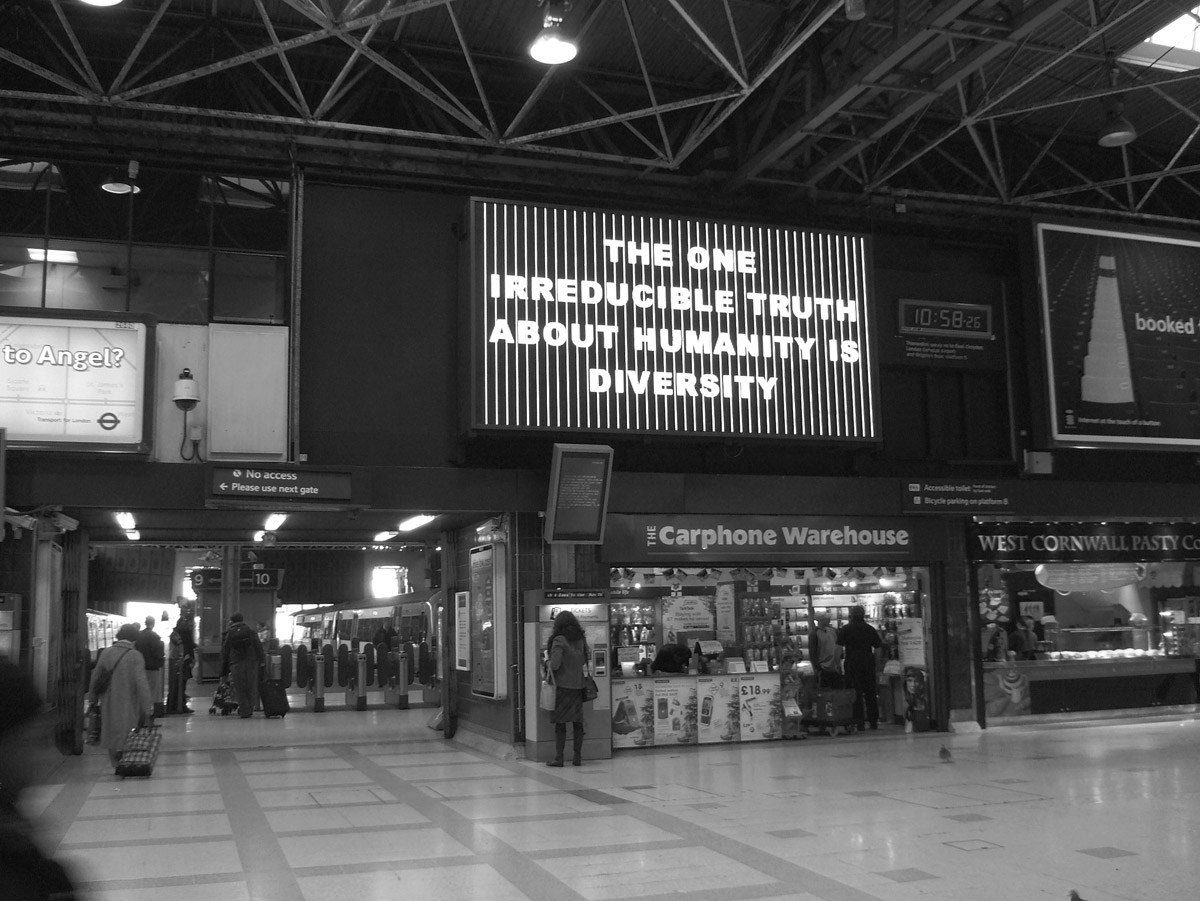
The One Irreducible Truth, 2005
2005.2
2007
Briefly takes an apartment in a block between the top of Rue Mouffetarde and Place Monge in the 5th arrondisement of Paris. 'That beautiful quarter with the Sorbonne and the Pantheon and the feeling that Liberty is ever at our side, poised to lead us in a new revolution of beauty and justice.'
Meets human rights activist Biana Jagger
NOTE
Bianca Jagger (born Blanca Pérez-Mora Macías 2 May 1945)is a Nicaraguan social activist, human rights advocate, and a former actress. Jagger currently serves as a Council of Europe goodwill ambassador, founder and chair of the Bianca Jagger Human Rights Foundation, member of the Executive Director's Leadership Council of Amnesty International USA, and a trustee of the Amazon Charitable Trust. She was married to Mick Jagger, lead singer of the Rolling Stones, from 1971 until 1978.
to discuss her inclusion in the proposed projection work
Complete Hero
(2009.1)
. Jagger agrees to meet on the condition that she 'does not want to talk about Mick'. Then talks about Mick, divorce, money. In her galley kitchen, she offers the artist Brazil nuts saying they are an important source of selenium. (
Complete Hero
is realised in 2009 with the Household Division of the British Army but without Jagger).

Artist's impression, Bianca Jagger, Complete Hero, British Museum, 2007 (unrealised)
p2007.1
Bianca let out a huge fingers-in-the-mouth whistle to hail a cab. Then she put on her makeup, saying she was used to doing it in war zones but it was much harder in the back of a black cab. When we arrived at the party, Bianca had donned dark glasses and was suddenly BIANCA JAGGER. It was a spectacular transformation. The people were bookish, clever, happy, boozy, irreverent. A man said to me, 'So are you WITH Bianca and I said, 'I’ve been with her all afternoon...'
Journal entry: 28.10.07
Creates two projection works for the Royal Opera House
Six Women
(2007.1)
and
It's Passion that Binds Us
(uncatalogued).
2008
Director Vera Baghiroli creates
Art in A Word,
a short form documentary about Firrell's working practice and aims. Although only 7 minutes long, this documentary is an uncannily comprehensive survey of the artist's ideas to date.
Art in a Word.
Dir. Vera Bagiroli, 2008. [Click image to play]
b2008.1
Appointed Public Artist in Residence at St Paul's Cathedral. Creates
The Question Mark Inside,
(2008.2)
a large-scale projection work marking the 300th anniversary of the topping-out of Christopher Wren's architectural masterpiece. Asks theologians, scientists, humanists, philosophers, artists, atheists, and the general public, 'What makes your life meaningful?' Creates a 'cascade of words' inspired by these contributions for projection onto the Dome, the West Front and the Whispering Gallery. Includes the text referring to the murder of Jean-Charles Menezes -
I Want to Live in a City Where the Police Don't Shoot you
- for the West Front. Dean and Chapter deny permission on the basis that the case is under judicial review. The text does appear inside the cathedral in the Whispering Gallery.
Producer Simon Channing Williams makes a documentary film about the year-long making of the artwork.
The Question Mark Inside,
(Special Treats UK, Dir. Roger Penny, 2009) airs in the UK, Australia, New Zealand and Canada.
And my love, my very real love for Simon Channing Williams which gives me all hope and all celebration and joy - that lovely, lovely man.
Journal entry: 10.6.06� ��
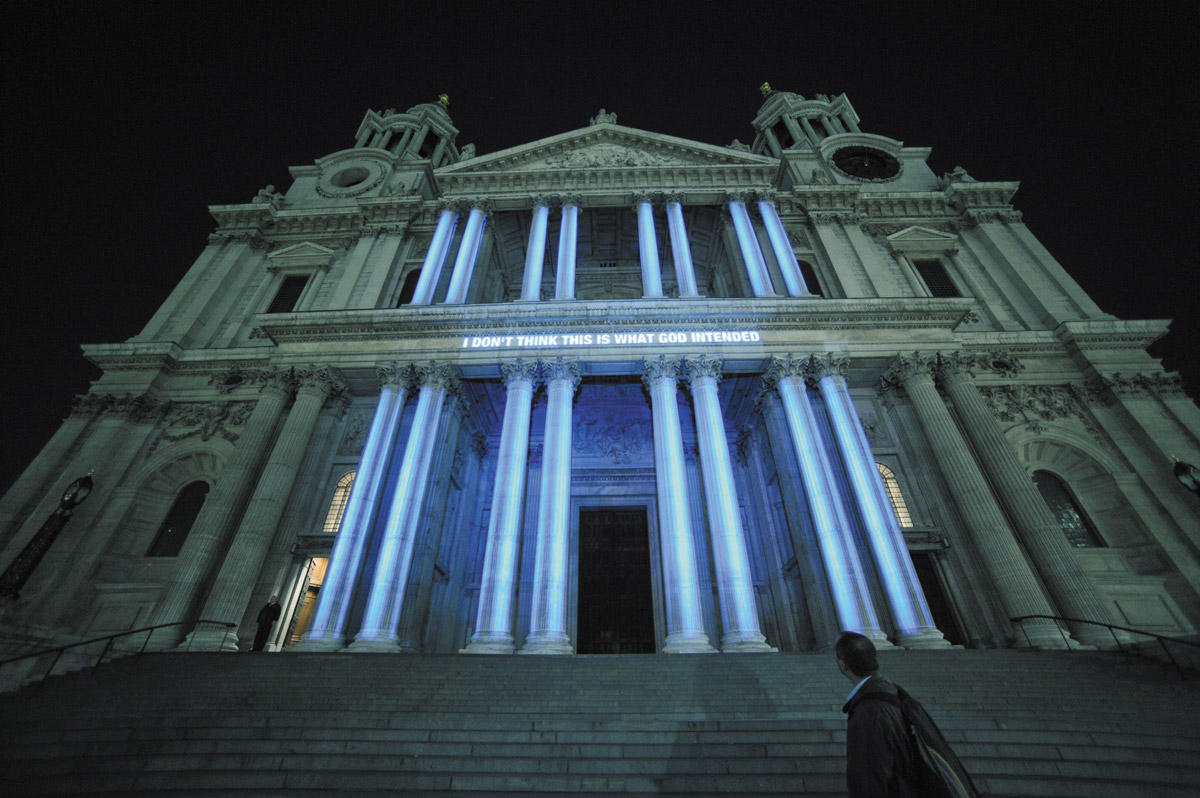
The Question Mark Inside, 2008
2008.2c
2009
Becomes Artist in Residence with the Household Division of the British Army under Major General Bill Cubitt.
Creates
Complete Hero,
a contemporary definition of heroism, reflecting the more sexually equal and multi-cultural nature of British society in the 21st century.
The artist interviews serving members of the British Army including senior officer, Major Fiona Laws, and Johnson Beharry holder of the Victoria Cross. Other participants include actor Nathan Fillion, comedian Shazia Mirza and a drag queen. The proposed artwork causes considerable consternation on presentation but is approved with no changes by Major General Bill Cubbit. Text, graphics and video interviews are projected onto the 1960s modernist elevations of the Guards' Chapel with sound delivered by wireless headsets.
Complete Hero, 2009, digital projections at The Guards' Chapel, Birdcage Walk, London UK
2009.1a
April Ashley MBE
NOTE
April Ashley MBE (1935 – 2021), styled as The Honourable April Corbett from 1963 to 1980, was an English model, author, and LGBT rights activist. Discharged from the Merchant Navy in the 1950s, Ashley performed under the stage name Toni April at Le Carrousel in Paris France. She was outed as a transgender woman by
The Sunday People
newspaper in 1961 and was one of the first British people known to have had gender confirmation surgery. Her first marriage, to the future 3rd Baron Rowallan, was annulled in the High Court of Justice case of Corbett v Corbett. Ashley was appointed a Member of the Order of the British Empire in the 2012 Birthday Honours for services to transgender equality.
contributes her story as one of the first people in the world to have gender confirmation surgery. Ashley's courage and grace in the face of daunting odds are celebrated as acts of contemporary and complete heroism.
Sigourney Weaver sits for the artist for
Complete Hero
. Her contribution is never released but Firrell creates an incidental portrait of the actress from the unused material.
2010-2012
Buys a fisherman's cottage in North Norfolk with the aim of 'altering life in some new way'. Works away from the distractions of London. Swims in the North Sea off the sand and shingle spit of Blakeney Point. 'The cold brings you into the moment and you feel keenly alive. I am also very afraid of the sea, though I love it, and so, again, one is aware of life itself; then there is the blue of the sea and the sky and the white of the nesting gulls, tumbling like blown paper as they fish to feed their chicks.'
Galerie IFF commissions 7 artists and designers to create text posters, using or commenting on the work of famed French typographer Roger Excoffon: Åbäke, Fiona Banner, Laure Provoust, Liam Gillick, Martin Firrell, Ryan Gander, and Stephane Le Mercier.
Avec Excoffon
(2010.1)
, a series of fly-posters displayed across Marseille marks the centenary of Excoffon's birth in that city (1910-1983).
Comprendre quelque chose pleinement, c'est pouvoir n'en rien dire, Marseille France, 2010
2010.1
2013-2014
Meets novelist William Jackson
NOTE
William Jackson (born 1966) is a British queer horror novelist. His books include the short story collection
Shapes in the Dark
(Cambridge Queer Press, 2021) and the novels
Satan's Lamp
(Cambridge Queer Press, 2023)
The Sugar Pit
(Cambridge Queer Press, 2024) and
Who's Afraid of Shirley Jackson
(Cambridge Queer Press, 2025). His work challenges heteronormative assumptions by setting horror narratives in homonormative worlds. The compelling, cinematic quality of his prose and its pansexual modernity, have prompted the epithet, 'Hammer horror for the 21st Century'.
in February 2013. Firrell's proposal of marriage is accepted in Paris in July of the same year. They marry at the Curzon cinema in London's Mayfair, with choc ices and champagne, on 13 September 2014.
Novelist William Jackson by Martin Firrell, Paris, 2013
b2013.1
Firrell and Jackson travel to Zürich in 2013, to Cabaret Voltaire, the home of Dada.
(see
DADA 105
2022.2.1 - 2022.2.4)
They visit the Atomium - vision of the future - in Brussels in July 2014 and honeymoon in Venice in September 2014, seeing both the Peggy Guggenheim and Francois Pinault collections. Firrell is struck in particular by the scale and repetitions of
Décor,
2011-2012 by Adel Abdessemed,
NOTE
Adel Abdessemed (born 1971) is a French contemporary artist of Berber origin, born in Constantine, Algeria. He works in a variety of media, including animation, installation, performance, sculpture and video. One of the artist's principal preoccupations is the operation of violence in the world. The three-volume catalogue raisonné,
Adel Abdessemed: Works 1988-2015,
published by Koenig Books, brings together nearly thirty years of creation. Abdessemed lives and works in Paris, France.
4 life-sized Christ figures sculpted in razor wire (from the Pinault Collection show,
Prima Materia (Raw Material)
at the Punta della Dogana.)
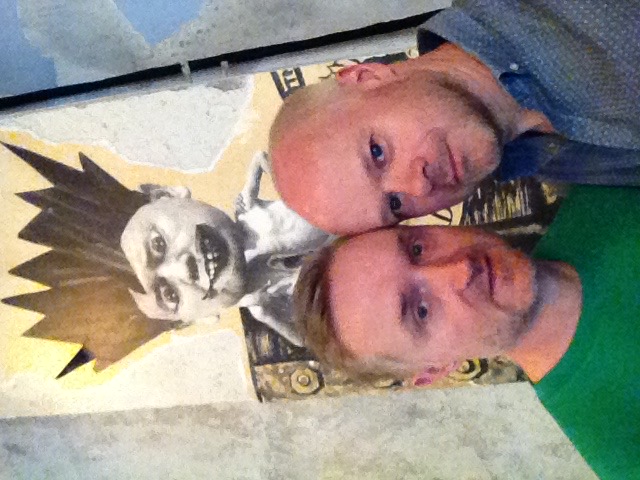
William Jackson and Martin Firrell, Cabaret Voltaire, Zurich Switzerland, 2013
b2013.1
In November of 2014, Jackson and Firrell travel to Alnwick in Northumbria. The artist buys a copy of
Blue of Capricorn
(1961) by American writer Eugene Burdick from Barter Books, a second-hand bookshop in Alnwick's former railway station.
NOTE
Eugene Leonard Burdick (1918-1965) was an American novelist, and non-fiction writer, a renowned public intellectual and a highly respected political scientist. His career was cut short when he died tragically of a heart attack at the age of 46.
His first novel,
The Ninth Wave
(1956) follows a political campaign exploring the implications of the then cutting-edge innovations of opinion polling, computers and the use of campaign consultants.
The 480
(1964) refers to the number of groups (by party affiliation, socioeconomic status, location, origin, etc.) used by a computer simulation to classify the American electorate. The novel is based on analysis carried out for John F Kennedy’s 1960 Presidential election campaign by the Simulmatics Corporation.
The Burdick is a meditation on the Pacific Ocean and the colour blue and it will go on to be an important influence in the 2020-21 poster series
Die Chromatika/The Chromatika
(2020.2.1 - 2020.2.7 & 2021.1.1 - 2021.1.3)
.
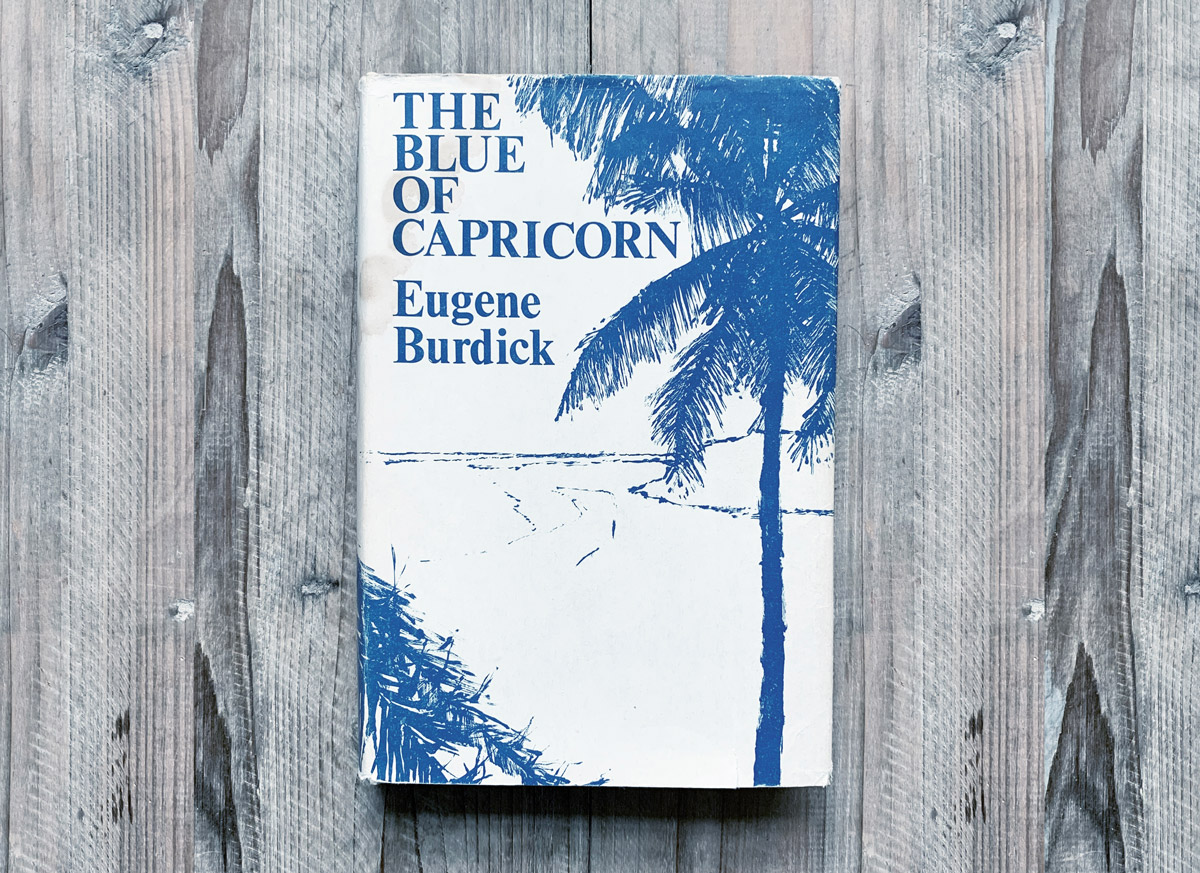
The Blue of Capricorn by Eugene Burdick, 1963
s2020.2.3
Meets filmmaker Lana Wachowski
NOTE
Lana Wachowksi (born 1965) is an American writer, director and producer. She is the writer and director, (with sibling Lilly Wachowksi) of many works most notably,
The Matrix
(1999),
The Matrix Reloaded
and
The Matrix Revolutions
(both 2003) and
Cloud Atlas
(2012), written and directed by the Wachowskis and Tom Tykwer, based on the 2004 novel by David Mitchell).
at the UK Gala screening of
Cloud Atlas
and conceives
Ten Thousand Years of Lana Wachowksi.
(2013.1)
Creates
MetaFenella
(2014), a practical tool for navigating life inspired by the vamps and
Carry On
vampires played by British actress Fenella Fielding, 'England's First lady of the double entendre'.
NOTE
Fenella Fielding (born Fenella Marion Feldman, 1927 – 2018) was an English stage, film and television actress who rose to prominence in the 1950s and 1960s, and was often referred to as 'England's first lady of the double entendre'. She was known for her seductive image and distinctively husky voice. Fielding appeared in two
Carry On
films,
Carry On Regardless
(1961) and, most famously,
Carry On Screaming!
(1966).
2015-2017
Meets with Matthew Dearden,
NOTE
Matthew Dearden is co-founder and Chief Executive of Alight Media. He was previously President of Clear Channel Europe, CEO of Clear Channel UK, and Marketing Director of British Telecom. He is an adviser to the Advertising Standards Authority.
President of Clear Channel Europe, to gain support for a new ambitious billboard project
All Identity Is Constructed
(2016.2)
.
In October 2015, Firrell and Jackson travel to Montpelier and Paris to see the Mediterranean ('so I can put my feet in it') and Andy Warhol's shadow paintings at the Musée d’Art Moderne.
NOTE
Andy Warhol,
Shadows,
1978–79, Acrylic on canvas, 102 paintings, 193 x 132cm each. 'I called them
Shadows
because they are based on a photo of a shadow in my office. It's a silkscreen that I mop over with paint. I started working on them a few years ago. I work seven days a week. But I get the most done on weekends because during the week people keep coming by to talk.'
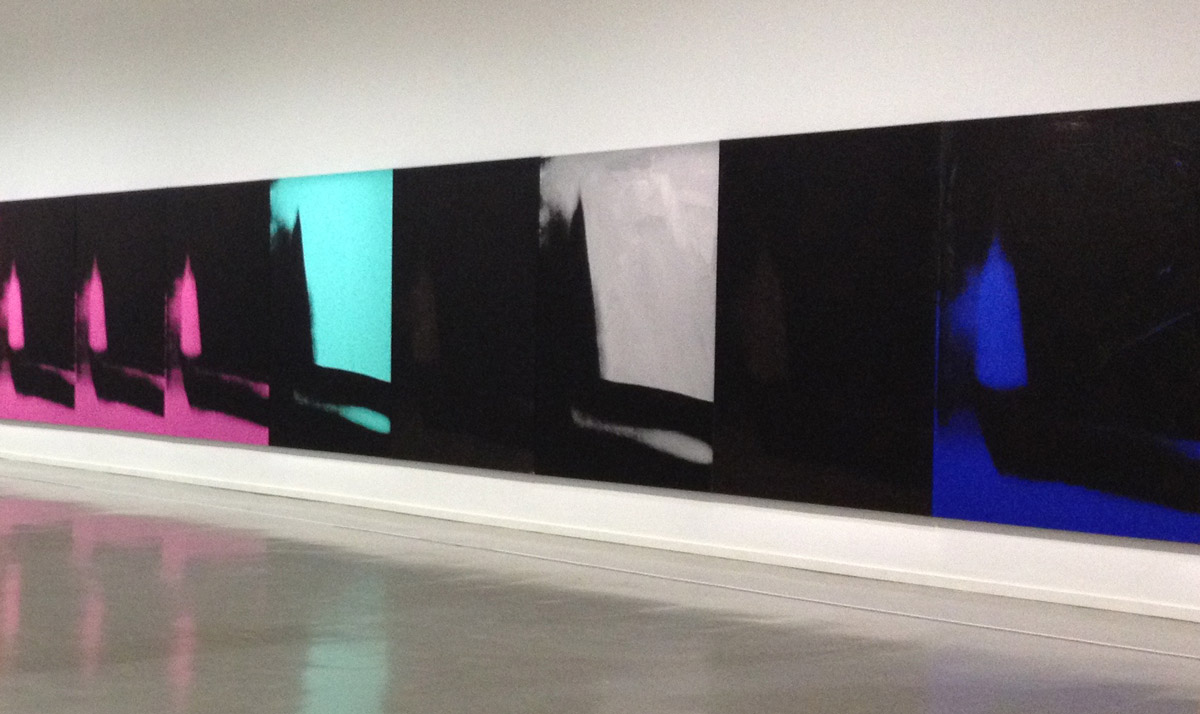
Shadow Paintings, Andy Warhol, Musée d’Art Moderne (MAM), Paris, 2015.
b2015.1
Creates
Como Vivimos/How We Live
(2016.1)
for the hill town of Fanzara near Valencia, Spain. The entire village is an open air museum of international street art called MIAU, The Museo Inacabado de Arte Urbano / The Unfinished Museum of Urban Art.
Jackson and Firrell stay on in Valencia visiting the enormous park planted in the former riverbed of Valencia's Turia river. The park leads to the modern opera house, the Palau de les Arts Reina Sofía, in the City of Arts and Sciences. The building, by the Valencian architect Santiago Calatrava,
NOTE
Santiago Calatrava Valls (born 1951) is a Spanish-Swiss architect, structural engineer, sculptor and painter, particularly known for bridges supported by single leaning pylons, and his railway stations, stadiums, and museums, whose sculptural forms often resemble living organisms.His largest project is the City of Arts and Sciences and Opera House in his birthplace, Valencia.
is much admired by the artist and his studio makes initial enquiries about creating a projection work for the opera but the artwork is never realised.
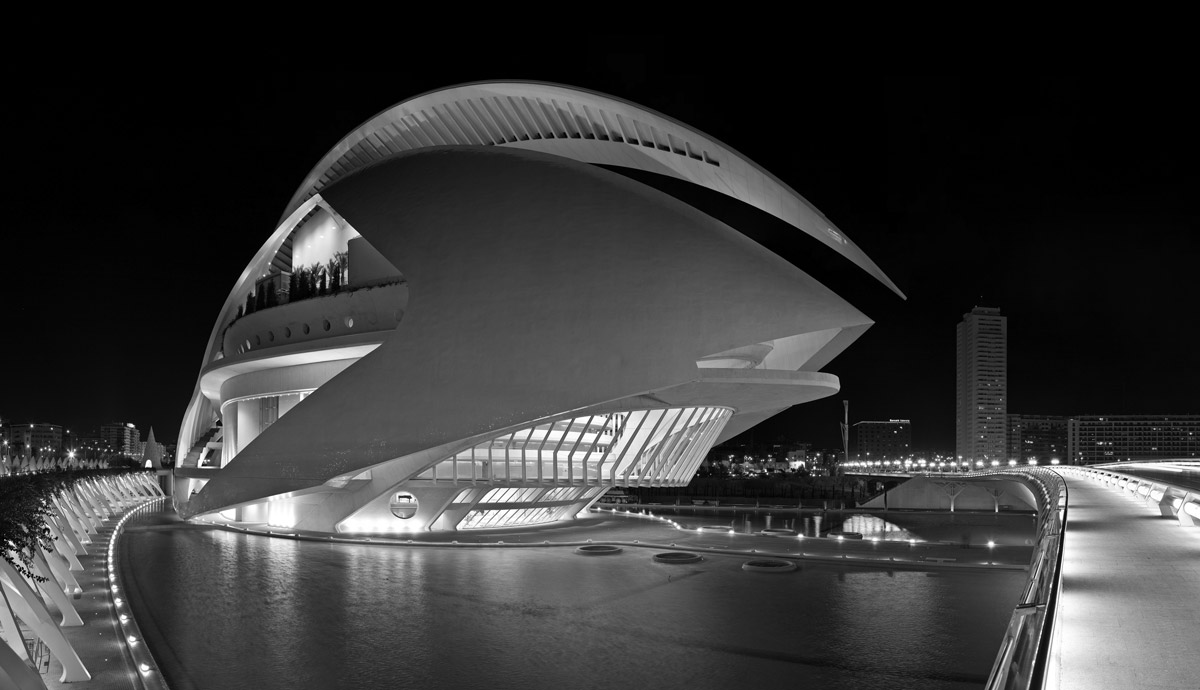
Palau de les Arts Reina Sofía, Valencia photographed by David Iliff (CC BY-SA 3.0.)
b2016.1
Creates
All Identity is Constructed
with the support of Clear Channel, Primesight and Outdoor Plus. Meets Clear Channel CEO Justin Cochrane
NOTE
Justin Cochrane (born 1972) is CEO, Europe, Clear Channel Outdoor; Chairman of Outsmart, the UK’s Out of Home industry trade body, and a board member of the Committee of Advertising Practice in the UK.
in Picadilly Circus as the work is tested on two full motion video billboards. Jackson and Firrell travel to the United Nations in Geneva. See Miquel Barcelo's ceiling for the Human Rights and Alliance of Civilizations Room.
NOTE
Miquel Barceló Artigues (born 1957) is a Spanish painter. He used 100 tonnes of paint to create multi-coloured stalactite forms that appear to be dripping from the ceiling of the Human Rights and Alliance of Civilizations Room in the United Nations building in Geneva, Switzerland.
All Identity Is Constructed (Tyler), 2016.
2016.2
All Identity is Constructed
wins the Daily Digital Out Of Home Award for best digital campaign 2016.
Meets Peter Tatchell to discuss the 50th anniversary of the 1967 Sexual Offences Act which partially decriminalised gay sex in England and Wales under certain circumstances. Firrell is keen to understand the full significance of the act. Meeting Tatchell feels like a culmination of events which began with his admiration for Tatchell in the 1980s as a principled and brave campaigner for gay rights.
Work begins on
Overthrow the Social Order
(Hyde Hill Productions / Dir. Oliver Guy Watkins), a documentary film following the artist's creation of
Remember 1967.
Justin Cochrane invites him to speak at the annual Clear Channel global conference, 2017.
Martin asked me whether I wanted him to be 'challenging' or more 'neutral'. I said challenging. Martin caused a bit of an uproar over dinner. Some people found his talk immensely provocative, some were extremely happy, feeling more comfortable than they'd ever felt because the company had fully recognised diversity. I believe Martin's talk helped to push the issue of fairness up the company agenda and created healthy debate about the true meaning of inclusion.
Convenes a Gender Think-In with the support of Dame Inga Beale, CEO Lloyd's of London.
NOTE
Dame Inga Kristine Beale, DBE (born 1963) was Lloyd of London's first female CEO in the insurance market's 328-year history. Beale, who is bisexual, was instrumental in the launch of Pride@Lloyds, an internal LGBT employee resource group, and has supported the LGBT Insurance Network.
The Think-In invites 200 leaders in business, culture and policy to the Lloyd's Building to take part in a thought experiment based on the consciousness-raising sessions conducted by the Gay Liberation Front in the 1970s.
2018-2020
Ugly Sweaty Men Become CEOs All the Time. Ugly Sweaty Women Don't, 2019
2019.1.1
Becomes Artist in Residence at Clear Channel UK. Meets and interviews Clare Short. Clare goes on to become an important advisor, supporter and friend. Creates five series of artworks for display across the UK:
Power and Gender, Women
(2019.1.1 - 2019.1.6)
featuring Clare Short, former Secretary of State; Inga Beale, former CEO, Lloyd's of London; Annie Rickard, former Global President, Posterscope; Liv Garfield, CEO Severn Trent Water; and Alex Mahon, CEO Channel 4;
Power and Gender, Men
(2019.2.1 - 2019.2.6)
featuring Canadian actor Nathan Fillion; Justin Cochrane, CEO Clear Channel, Europe; writer Adam Nicolson and American actor Burt Reynolds;
3 Billboards for Blair Peach
NOTE
Clement Blair Peach (1946 – 1979) was a New Zealand teacher who was killed during an anti-racism demonstration in Southall, London, England. A campaigner and activist against the far right, in April 1979 Peach took part in an Anti-Nazi League demonstration in Southall against a National Front election meeting in the town hall and was hit on the head, probably by a member of the Special Patrol Group (SPG), a specialist unit within the Metropolitan Police Service. He died in hospital that night.
(2019.3.1 - 2019.3.3)
; Union City
(2019.4.1 - 2019.4.9)
with Clare Short and Frances O'Grady then General Secretary of the TUC;
Skin
(2019.5.1 - 2019.5.4)
for Black History Month; and
Counter Culture Rising
(2020.1.1 - 2020.1.12)
an antidote to Trumpism and Brexit inspired by the hippy movement.
Corresponds with Jo Freeman, a student at the University of California, Berkeley in the 1960s and an early organiser of the women's liberation movement.
Jo introduced me to John McAuliff, now the executive director of the Fund for Reconciliation and Development (FRD). The FRD works to re-establish normal diplomatic, cultural, educational and economic relations between the United States and Vietnam, Cambodia, Laos and Cuba. John in turn put me in touch with Judy Gumbo and Nancy Kurshan, founder members of the anti-war group the Youth International Party or Yippies. In 1972, the FBI described Judy as 'the most vicious, the most anti-American, the most anti-establishment, and the most dangerous to the internal secuirty of the United States'. I liked her.
Jackson and Firrell travel to Basel, Switzerland in September 2019 to visit Rudolf Steiner's Goetheanum in Dornach.
NOTE
Rudolf Joseph Lorenz Steiner (1861-1925) founder of the Anthroposophical Society, cultural theorist, architect of the Goetheanum at Dornach, Basel Switzerland.
Firrell's imagination is caught by the poured concrete architecture and by Steiner's ideas on education, spirituality, health and art. In particular, the artist explores Steiner's writings on colour and those of Steiner's hero, Johann Wolfgang von Goethe.
NOTE
Johann Wolfgang von Goethe (1749 – 1832) was a German polymath, widely regarded as the greatest and most influential writer in the German language. His work has had a profound and wide-ranging influence on Western literary, political, and philosophical thought. A poet, playwright, novelist, scientist, statesman, theatre director, and critic, his works include plays, poetry and aesthetic criticism, as well as treatises on botany, anatomy, and colour.
These investigations will lead to
Die Chromatika/The Chromatika
the artist's own psychological theory of colour for the 21st Century.
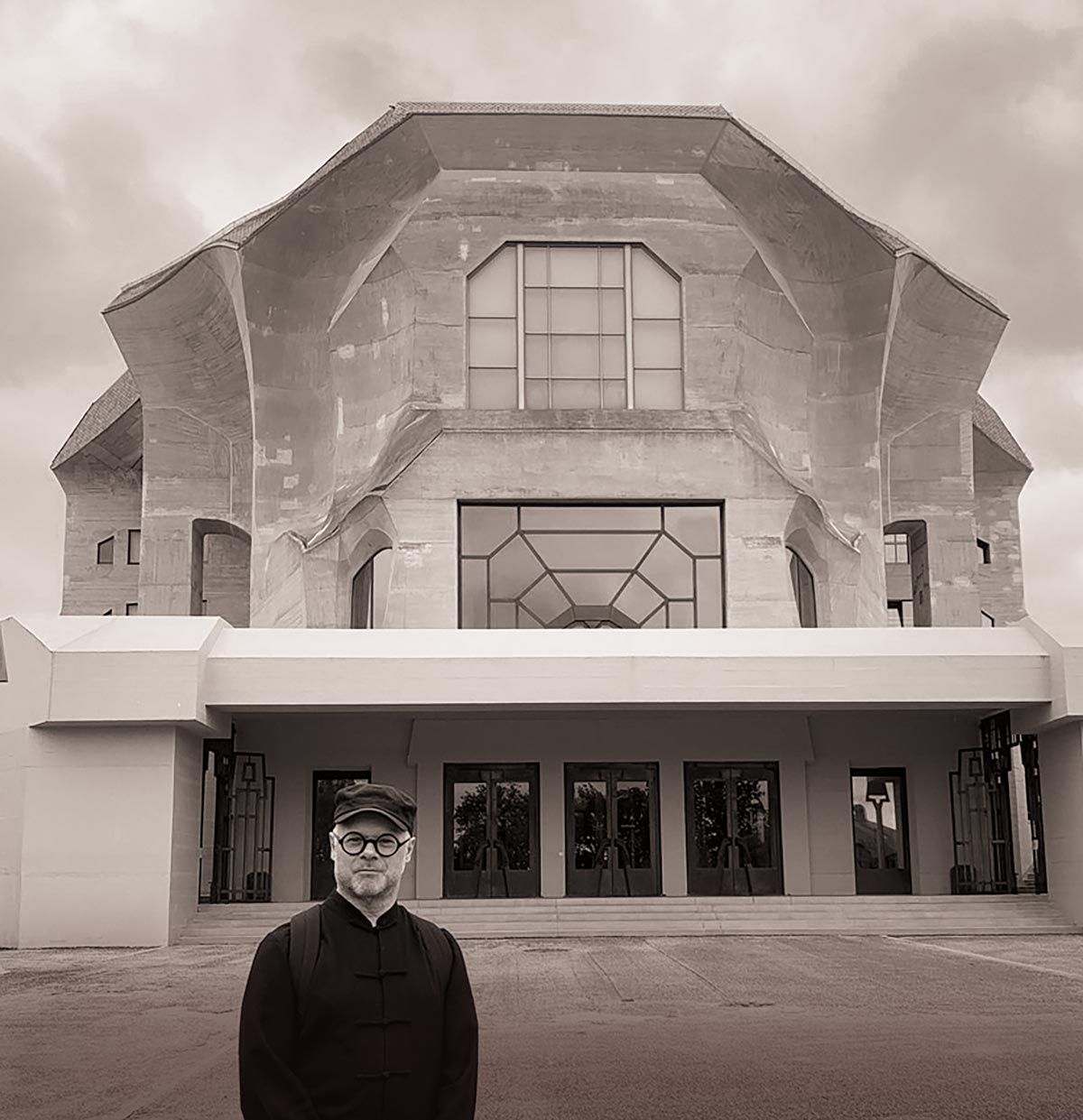
The artist at the Goetheanum, Dornach Switzerland by William Jackson, 4 October 2019.
b2019.1
Counter Culture Rising
appears at the beginning of 2020 and is the artist's largest series of artworks to date. Although composed of individual billboards which may be encountered in any order, the series conveys a cinematic story of alien visitation, warnings about climate catastrophe and war, the threat posed by machine intelligence, the power of living peacefully and advanced states of consciousness.
The Covid-19 pandemic triggers the UK's first lockdown. At the time, Firrell and Jackson are holidaying at their home in Norfolk so stay there. They will remain on the coast for a further 5 years. One of the ironies of lockdown is that it frees space and time for new thought and new work.
Martin Firrell,
a monograph by Barbara Ulbrist is published by Zurich Books on 4 April 2020. Ulbrist's volume concentrates on the period 2018-2020 when Firrell is Artist in Residence at Clear Channel creating some 40 separate billboard artworks.
Completes
Die Chromatika/The Chromatika,
7 German-language digital posters for Switzerland. The work is a caprice, an aesthetic joke, claiming to provide an absolute psychological definition for each of the colours of the spectrum. 'I didn't want to comment on the pandemic. It felt too soon. Instead, I took comfort in returning to pure aesthetics, considering my own, personal relationship with each of the spectral colours.

Indigo Is Measureless as the Uniform Blue-Black of the Deep Pacific,
2020 from
Die Chromatika.
2020.2.5
Works with Peter Tatchell to create
Homosexuals Are Still Revolting,
(2020.3.1 - 2020.3.4)
marking the 50th anniversary of the founding of the Gay Liberation Front in the UK.
In 1973, Tatchell marched at London Pride with a home-made placard saying 'homosexuals are revolting'. In conversation with the artist Tatchell recalled: 'I thought, turn it on its head: people think we are revolting; no, no, we are REVOLTING! fighting back, you know.' Five decades later, Firrell reponds with 'Homosexuals Are Still Revolting' reflecting the truth that homosexuality is still regarded as intolerable by some and many LGBT+ people are still struggling for acceptance, equality and security.
Peter Tatchell, Gay Pride, 1973. Courtesy of Peter Tatchell.
s2020.3
2021
Sees
Die Große Stille (Into Great Silence),
a 2005 documentary film directed by Philip Gröning. It is an intimate portrayal of the everyday lives of Carthusian monks of the Grande Chartreuse, a monastery high in the French Alps. Gröning proposed the idea for the film to the monks in 1984. They said they wanted time to think about it. 16 years later, they agreed to Gröning's proposal. The film contains neither spoken commentary nor added sound effects.
'It was very important for me to see
Die Große Stille.
I came to it via the colour Green Chartreuse. I had been working on a book form of
Die Chromatika/The Chromatika
and I was taken by very specific colour names like Citrine Yellow and Green Chartreuse. The colour led to the liquer and the liquer to the monastery.
I found
Die Große Stille
profoundly affecting because Gröning allowed the material to speak for itself. It is as if he did very little, almost nothing, in order to allow the material to reveal its own truths. I had been trying to do the same with very direct language, nothing hidden or implied but everything simply stated. I was also struck by the film's relationship with time. The monks thought it over for 16 years before saying yes. The film itself is a kind of meditation on time; how it matters and does not matter; that time, simply, is.'

Green Chartreuse / Charteuse Grün (Grande Chartreuse Monastery)
from
Die Chromatika,
2021
2021.1.4k
The three posters in the series
Die Chromatika Neutrals
(2021.1.1 - 2021.1.3)
appear across Switzerland: meditations in German on the 'meaning' of the neutral colours: Grau, Weiss, and Schwarz (Grey, White, and Black).
Publishes
Die Chromatika/The Chromatika, Eine psychologische Farbenlehre für das 21. Jahrhundert/A psychological theory of colour for the 21st Century, 2021
(2021.1.4)
.
This volume places all ten posters in the context of wider colour theory, including a brief history of pigments and Baron von Reichenbach's Odic force.
NOTE
Karl Ludwig Freiherr von Reichenbach (1788 – 1869), known as Carl Reichenbach, was a German chemist, geologist, metallurgist, naturalist, industrialist and philosopher, and a member of the Prussian Academy of Sciences. He is best known for his discoveries of several chemical products of economic importance, extracted from tar, such as eupione, waxy paraffin, pittacal (the first synthetic dye) and phenol (an antiseptic). He dedicated his last years to researching an unproved field of energy combining electricity, magnetism and heat, visible in total darkness as colored auras surrounding living things, crystals, and magnets, which he called the Odic force.
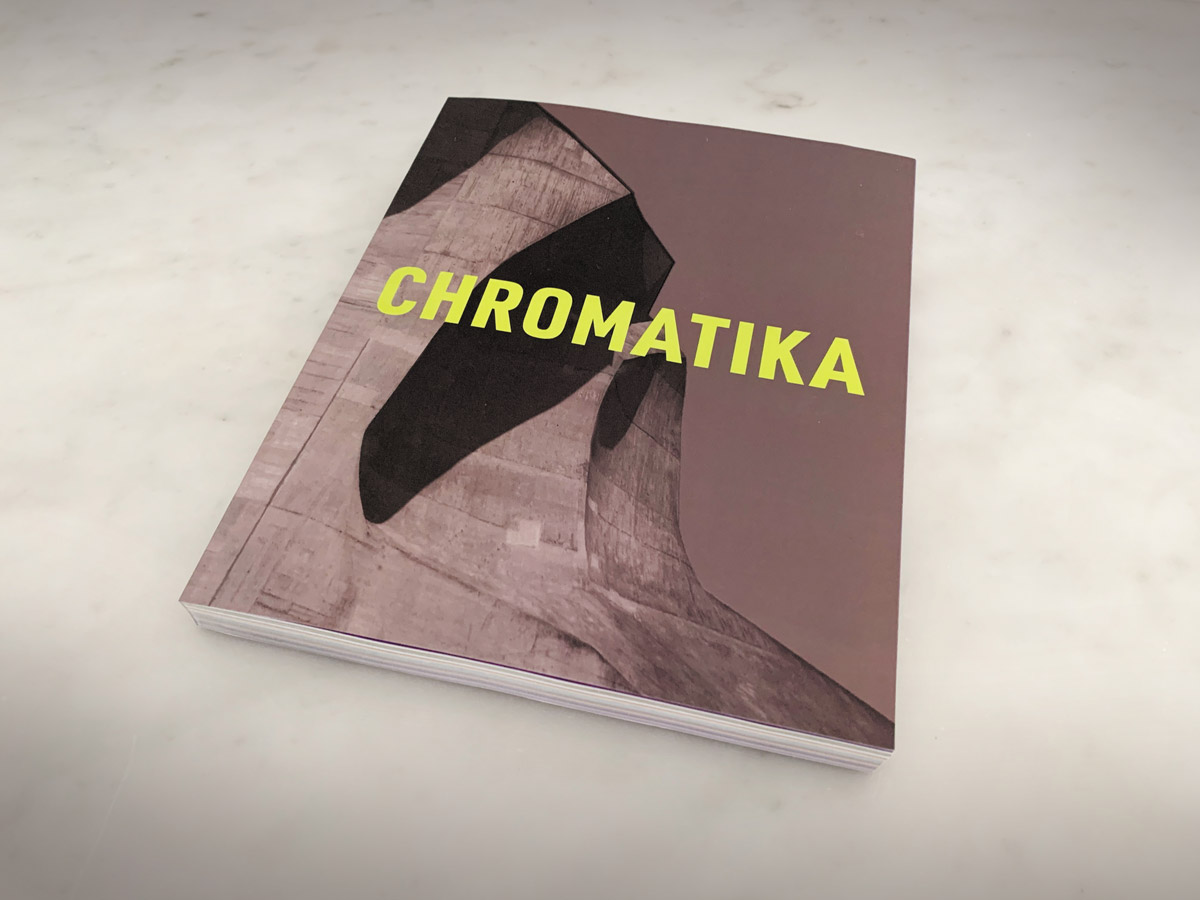
Die Chromatika/The Chromatika, Eine psychologische Farbenlehre für das 21. Jahrhundert/A psychological theory of colour for the 21st Century,
2021, featuring the biomorphic concrete forms of the Goetheanum in Dornach, Switzerland
2021.1.4
Develops
This Land
(2021.2)
for the Woolworth Building in the city centre of Sydney, Australia. Works with Nathan Moran, CEO of the Metropolitan Local Aboriginal Land Council (MLALC) in Sydney to understand the relationship between the First Nation Gadigal People and the site. The artwork calls for white Australia to defer authority over the land to its original owners. It was not selected for display.
This Land,
2021, plan for the Woolworth Building, 532-540 George St, Sydney Australia.
2021.2a
Refers to earlier conversations with Clare Short about the rights and experience of working class people in the UK. Develops
Straight White Working Class
(2021.3.1 - 2021.3.5)
to investigate what it means to be working class in the UK / blue collar in the US. Conducts extended research into the lives of men who identify as working class / blue collar in the post-industrial cities of Detroit and Philadelphia in the US and Leeds and Newcastle in the UK. The artworks are based on verbatim comments from the men and all images in the series are gifted to the artist by the men from their personal archives. This allows the material to 'speak for itself' as in Göning's
Die Große Stille.
2021 marks the 200th anniversary of the Manchester Guardian, a left-leaning UK newspaper. The artist proposes
Guardian 200
(2021.5.1 - 2021.5.4)
, a series that anticipates milestones for the next 200 years of the progressive project. In particular, he becomes interested in the idea that gay sex will not merely be tolerated but celebrated for its unique expressive possibilities.
Guardian 200
references sexualised clothing like the jockstrap and LGBT+ events like San Francisco's annual BDSM festival, the Folsom Street Fair.

Gay Sex Will Be Celebrated (Jocks),
2021, featuring documentary photograph of San Francisco's annual Folsom Street Fair.
2021.5.2
2022
Kessler Academic begins work on the current catalogue raisonné under the editorial directorship of Dr Robert Shelton. The catalogue will focus on the artist's work in the billboard form. Development, research, archival and digitisation work will take three years to complete.
As a catalogue raisonné in preparation,
the work is ongoing and open ended.
Reads the complete writings of Andy Warhol, with a particular interest in Warhol's relationship with his earlier career as a commercial artist:
When Warhol saw the billboards along Route 66, he saw them as pure Pop Art. Where most people saw only American advertising, he saw American high art. Burma-Shave offered a compound riddle told across 6 separate billboards: If you / Don’t know / Whose signs / These are / You can’t have / Driven very far / Burma-Shave. Wilson’s Ham shouted from the roadside, ‘No waste, Great taste!’ And Coppertone promised the ‘Fastest tan under the sun’. ‘It was a beautiful time to be driving across America!’ Warhol said.
Begins a series of works based on Vanessa Bell and Duncan Grant's dinner service
Famous Women.
NOTE
Vanessa Bell (née Stephen 1879 – 1961) was an English painter and interior designer, a founding member of the Bloomsbury Group and the sister of Virginia Woolf (née Stephen). Duncan James Corrowr Grant (1885 – 1978) was a fellow Bloomsbury Group member and Bell's life partner; a Scottish painter and designer of textiles, pottery, theatre sets, and costumes.
The Famous Women Dinner Service
is a collection of 50 hand-decorated plates by Vanessa Bell and Duncan Grant, celebrating famous women throughout history. The last two in the series depict Vanessa Bell and Duncan Grant, the only man in the series.
Firrell's version is
Infamous Women
featuring Ulrika Meinhoff,
NOTE
Ulrike Marie Meinhof (1934 – 1976) was a German left-wing journalist and founding member, with Andreas Baader, of the Red Army Faction (RAF) more commonly known as the Baader-Meinhof gang.
The Urban Guerilla Concept
published in 1971 and attributed to Meinhof acknowledges the RAF's 'roots in the history of the student movement' and condemns 'reformism' as 'a brake on the anti-capitalist struggle'. Meinhof, who took part in the RAF's May Offensive in 1972, was arrested in June of that year and spent the rest of her life in custody, largely isolated from outside contact. In November 1974, she was sentenced to 8 years in prison for an attempted murder that had taken place during the RAF's successful jailbreak operation of Andreas Baader. She reappeared in court to answer multiple charges of murder and attempted murder with the three other RAF leaders: Baader, Gudrun Ensslin, and Jan-Carl Raspe. Before the end of the trial, she was found hanged in her cell in the Stammheim Prison.
Valerie Solanas,
NOTE
Valerie Jean Solanas (1936 – 1988) was an American radical feminist known for her
SCUM Manifesto
and for shooting the artist Andy Warhol in 1968. The
SCUM Manifesto,
self-published in 1967, urged women to 'overthrow the government, eliminate the money system, institute complete automation and destroy the male sex.'
In New York City, Solanas asked Warhol to produce her play
Up Your Ass.
Warhol claimed to have lost her manuscript, after delays and obfuscation.
On June 3, 1968, Solanas went to The Factory, shot Warhol and art critic Mario Amaya, and attempted to shoot Warhol's manager, Fred Hughes. She then turned herself in to the police. She was charged with attempted murder, assault, and illegal possession of a firearm. She pleaded guilty to 'reckless assault with intent to harm,' serving a three-year prison sentence, including treatment in a psychiatric hospital for paranoid schizophrenia. After her release, she continued to promote the
SCUM Manifesto.
She died in 1988 of pneumonia in San Francisco.
Patty Hearst
NOTE
Patricia Campbell Hearst (born 1954) is the granddaughter of American publishing magnate William Randolph Hearst. In 1974 she was kidnapped by the Symbionese Liberation Army. 19 months after her abduction she was arrested for serious crimes allegedly committed with members of the group. At her trial, the prosecution suggested Hearst had joined the Symbionese Liberation Army of her own volition. Hearst testified that she had been raped and threatened with death while held captive.
In 1976, she was convicted for the crime of bank robbery and sentenced to 35 years in prison, later reduced to seven years. Her sentence was commuted by President Jimmy Carter, and she was later pardoned by President Bill Clinton.
and Angela Davis
NOTE
Angela Yvonne Davis (born 1944) is an American Marxist and feminist political activist, philosopher, academic, and author. She is a professor at the University of California, Santa Cruz. Davis was a longtime member of the Communist Party USA (CPUSA) and a founding member of the Committees of Correspondence for Democracy and Socialism (CCDS). In 1970, guns belonging to Davis were used in an armed takeover of a courtroom in Marin County, California, in which four people were killed. Prosecuted for three capital felonies — including conspiracy to murder — she was held in jail for over a year before being acquitted of all charges in 1972.
in a series of four ceramics.
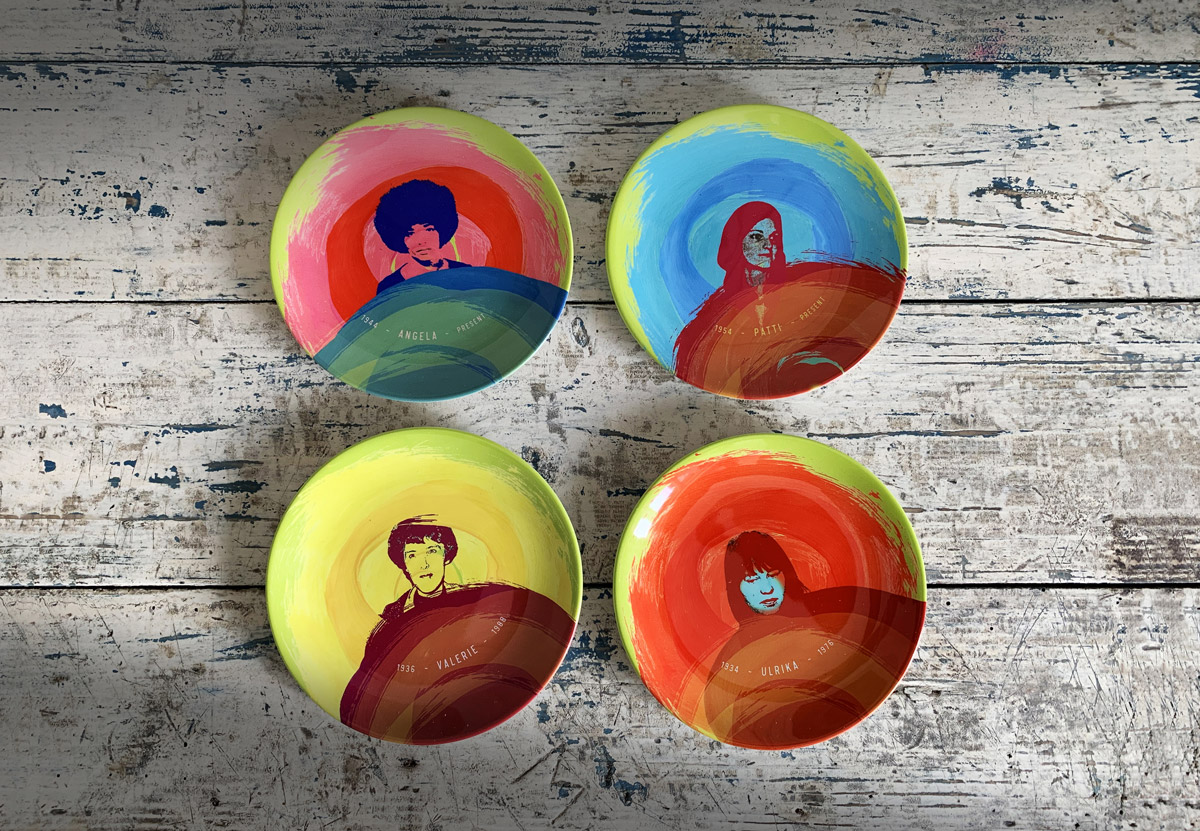
Infamous Women: Angela, Patti, Valerie, Ulrika,
2023
u2023.1
These meditations on the lives of complex women prompt further works based on contemporary newspaper reports about Valerie Solanas and Patty Hearst
(2021.6.1 & 2021.6.2 & 2023.1.1 & 2023.1.2)
. Firrell manipulates the newsprint to retell the women's stories with the benefit of hindsight. For example, Solanas was not named in the original reports of the Warhol shooting and was described, inaccurately, as 'an actress'. Solanas is now regarded as one of the 20th Century's most important feminist voices and Firrell's re-manipulation of the story turns her into the named protagonist and Warhol into an anonymous, but accurately described, 'artist'.
Embarks on a series of LGBT+ moving image works starting with
Beware of Boys
and
How To Be Popular
(2021.8 & 2021.9)
. These works are the moving image equivalents of the manipulated newsprint. Re-edited films from the Prelinger Archive undermine the homophobic and heteronormative assumptions of the original material.
2021.8
Self Portrait (on Fire Island)
(2021.7)
is a 6 frame gif derived from 16mm footage shot on Fire Island in the 1970s. The degraded image makes it impossible to identify the artist with any certainty (and the artist himself will not be drawn on the subject). The most that can be said, then, is that the image is a cypher for self-representation, almost certainly an ironic reference to the rise of the selfie, and a comment on the acute body consciousness customarily found in the gay community.
Self Portrait (on Fire Island),
2021. 5-frame gif, RGB colour from digitised 16mm film
2021.7
Works with Peter Tatchell once more, this time to mark the 50th anniversary of the first Pride march in the UK in 1972.
Pride 50
(2022.1.1 - 2022.1.4)
and
5 Decades of Pride
(2022.3.1 - 2022.3.5)
complete a triptych of commemorations that began with
Remember 1967
(for the 50th anniversary of the UK 1967 Sexual Offences Act) and
Homosexuals Are Still Revolting
(for the 50th anniversary of the founding of the Gay Liberation Front in the UK).
Creates
Dada 105
(2022.2.1 - 2022.2.4)
for Zürich and Basel, Switzerland, marking 105 years since Tristan Tzara published the first 4 editions of the review
Dada
from the city of Zürich. Firrell's artworks reproduce tears, foxing and irregular inking from the original pamphlets to evoke the fragility of the Dada-ists' ideas. The texts restate Dada-ist philosophy still pertinent to our own times now that war has returned to Europe.
What Oppresses Us Shapes Our Desires,
2022.
2022.4
What oppresses Us Shapes Our Desires
(2022.4)
concludes the year's work, drawing on French feminist theory. French feminism observed that the oppressor, by definition, is able to shape all of the responses of the oppressed, including what is found erotic or desirable. Firrell experiments with images of 'manspreading' (conincidentally banned on the underground in Madrid, Spain as anti-social behaviour). The artist expects a backlash of complaints when the work is made public but only one complaint is received, suggesting the public's relationship with male sexuality is less fraught than the artist anticipated.
2023
4 Tenets for Europe
(2023.2.1 - 2023.2.18)
is commissioned by Clear Channel Europe to mark the United Nations International Day of Democracy. The work presents gestural brush strokes of the colour green chartreuse, inspired by the film Die Große Stille. The work marks 25 years of the artist's association with Clear Channel UK and appears simultaneously in 9 languages in 11 European countries: Denmark, Finland, France, Ireland, Latvia, Netherlands, Norway, Poland, Spain, Sweden, and the UK.
Gestural brush strokes, derived from green chartreuse acrylic paint on paper, 2023.
s2023.2.16
'I also had in mind Krzysztof Kieślowski's film
Three Colours: Blue
with its
Song for the Unification of Europe;
NOTE
Krzysztof Kieślowski (1941 – 1996) was a Polish film director and screenwriter. Three Colours Blue is the first of his acclaimed Three Colours trilogy and centres on the destruction, resurrection and completion of a Song for the Unification of Europe. The music was composed by Zbigniew Preisner (born 1955).
I wanted my
4 Tenets
to be unifying truths about life and how to live it well. I wanted to venerate justice, in the sense of fairness, above all else.'
Investigates the later life of Matisse.
NOTE
Henri Émile Benoît Matisse (1869 – 1954), a French painter known for his bold and original use of colour and his fluid, distinctive draughtsmanship. He was also a printmaker and sculptor. He is regarded as one of the artists in the vanguard of revolutionary developments in the visual arts in the opening decades of the 20th Century. In later life, painting and sculpture became physically impossible for Matisse so he turned to cutting sheets of paper, pre-painted with gouache by his assistants, into shapes of varying colours and sizes, and arranging the pieces to form compelling and often large-scale compositions. The result was a distinct and dimensional complexity — an art form that was not quite painting, not quite sculpture.
In particular, the idea of late flowering and new directions in the third age of an artist's life. Matisse's cutouts and the Chapel of the Rosary at Vence exert a strong influence over the tone and style of work-in-progress
All Varieties
(2024.4.1 - 2024.4.17)
.
Jackson and Firrell spend the first of several holidays at Houghton West Lodge, a Landmark Trust gate house at Houghton Hall, West Norfolk. The lodge has no telephone, no television, no broadband and no mobile phone signal. They walk in woodland, read, write, cook, sit by the fire, plan new works.
Begins correspondence with Amanda Lear, singer, artist, actress and muse in her youth to Salvador Dalí.
NOTE
Amanda Lear (née Tap or Tapp, born 1939 or 1941 or 1946 or 1950 in Saigon or Hong Kong or Hanoi) is a French singer, songwriter, painter, television presenter, actress and former model. In the mid-1960s, she met Spanish surrealist painter Salvador Dalí becoming his closest friend and muse. Lear has variously let it be known that her mother was English or French or Vietnamese or Chinese, and that her father was English, Russian, French or Indonesian. She may have been born in Hanoi in 1939, or Hong Kong in either 1941 or 1946. Once she said she was from Transylvania. And to this day, it is a matter of conjecture as to whether she was born a boy or a girl.
Claims that Lear was a drag queen, or intersex, circulated from the beginning of her modelling and singing careers. In 1976, Lear described it as 'a crazy idea from some journalist' and later claimed that the rumour had been started by Dalí or even herself.
Reads Lear's
My Life with Dali,
bookending an interest that began with the television documentary
Hello Dali
in 1973. Begins first exploratory work on
Amanda Lear Project
, a work in progress about the meaning of Lear's experiences. The artist is drawn to the ongoing speculation about whether or not Lear may be a trans woman, as Dalí may have claimed.
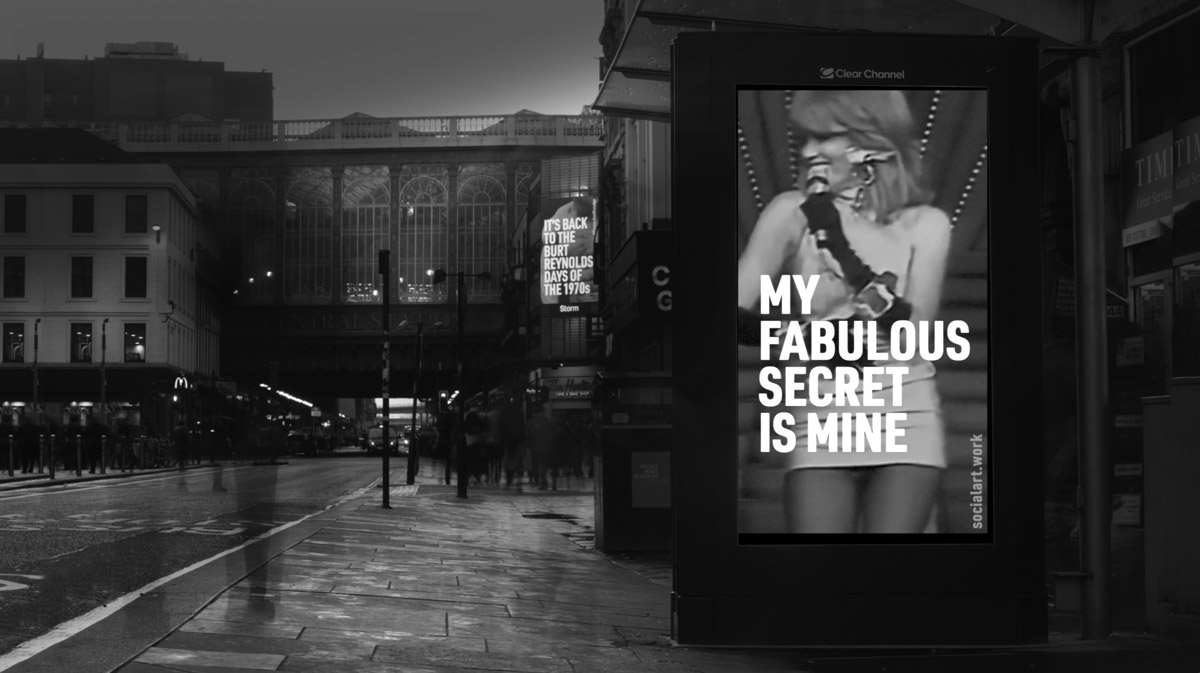
Prototype for the
Amanda Lear Project,
2025.
p2025.1
2024
Clear Channel UK supports
Women and Power
(2024.1.1 - 2024.1.7)
, a sequel to the artist's earlier investigations into the way women gain, regard, and use power
(see 2019.1.1 - 2024.1.7)
.
The participating women in the new series are Rebecca Salter PRA, President of the Royal Academy of Arts; Carolyn McCall, CEO of ITV; Joanne Harris, novelist and former Chair of the Society of Authors; Heather Hancock, Master of St John's Cambridge; Maggi Hambling, painter and sculptor; Julia Hoggett, CEO of the London Stock Exchange, and Ngozi Fulani, CEO Sistah Space.
'Women and Power brought me the friendship of Rebecca Salter and Julia Hoggett, an extraordinary studio visit with Maggi Hambling, and a great squaring of the circle in my meeting with Joanne Harris whose Franco-British work I had so long admired.'
With Maggi Hambling in her studio, 17 February 2024.
b2024.1.5
The artist joins forces again with Matthew Dearden, now CEO of Alight Media. The first in a three year series of public artworks is
Astronaut
(2024.3.1 - 2024.3.3)
featuring Helen Sharman.
NOTE
Helen Patricia Sharman (born 1963) is a British chemist and cosmonaut who became the first British person, first Western European woman and first privately funded woman in space, as well as the first woman to visit the Mir space station.
Britain's First Astronaut Preferred Womens Underwear
plays on, and undermines, the assumption, generally held in the UK, that astronauts are men.
Dr Robert Shelton describes Firrell's
All Varieties
(2024.4.1 - 2024.4.17)
as 'a late career masterwork like the paper cutouts of Matisse'. The work is the largest series of linked artworks the artist has ever made, characterised by ruthless simplicity of means and outrageously ambitious scale. The work also includes a flag for wine merchants Berry Bros. & Rudd, the project sponsors, which flies outside 3 St James's encouraging London's establishment to 'embrace all varieties'.

Trans
from the series
All Varieties,
2024.
2024.4.5
'I used black and white for the narrative elements of the work, as Matisse used black and white in the chapel at Vence. Instead of stained glass for colour, I created same-sex kisses from 1950s colour illustrations, dividing the men from the women and reuniting them in same-sex pairs.'
The year closes with
100 Years of Surrealism
(2024.5.1 - 2024.5.7)
for Belgium. The series consists of 3 artworks, each one executed in French and Flemish language versions. Firrell's celebration of Surrealism concentrates on Yvan Goll's
NOTE
Yvan Goll (born Isaac Lang, 1891 – 1950), a French-German poet who wrote in both French and German. In 1924 he founded the magazine
Surréalisme
in Paris, and wrote and published the surrealist movement's first manifesto.
manifesto, published 14 days before André Breton's more famous
Manifeste du surréalisme.
'I was interested in Goll's slightly different definition of Surrealism which involved understanding the fundamental mechanics, the inner workings, of reality to attain a higher or sur-reality. I used gifs to create motion that goes nowhere, movement with no direction, no vector. I wrote about reality as I believe Goll saw it. Simultaneously, I translated Goll's original manifesto from French into English because I couldn't find an extant English translation. The Cambridge Queer Press published a bilingual edition of Goll's
First Manifesto of Surrealism.
This seemed to me a great way to end the year, bringing attention to a thoughtful and interesting man who had been eclipsed by Breton and his cronies.'
Firrell and Jackson spend their tenth anniversary in Aldeburgh on the Suffolk coast. The pair return to Houghton West Lodge where Jackson works on a new novel and Firrell reads Annie Ernaux for the first time.
NOTE
Annie Thérèse Blanche Ernaux (born 1940), a French writer who was awarded the 2022 Nobel Prize for Literature 'for the courage and clinical acuity with which she uncovers the roots, estrangements and collective restraints of personal memory'. She has been credited with creating a new literary form: 'collective biography', in which the biographical experiences of an entire generation are charted, described and preserved.
Reading Ernaux is an enlivening experience because, in his own words, he was encountering 'someone who can compete with Duras for my attention, with Woolf or even Stein.
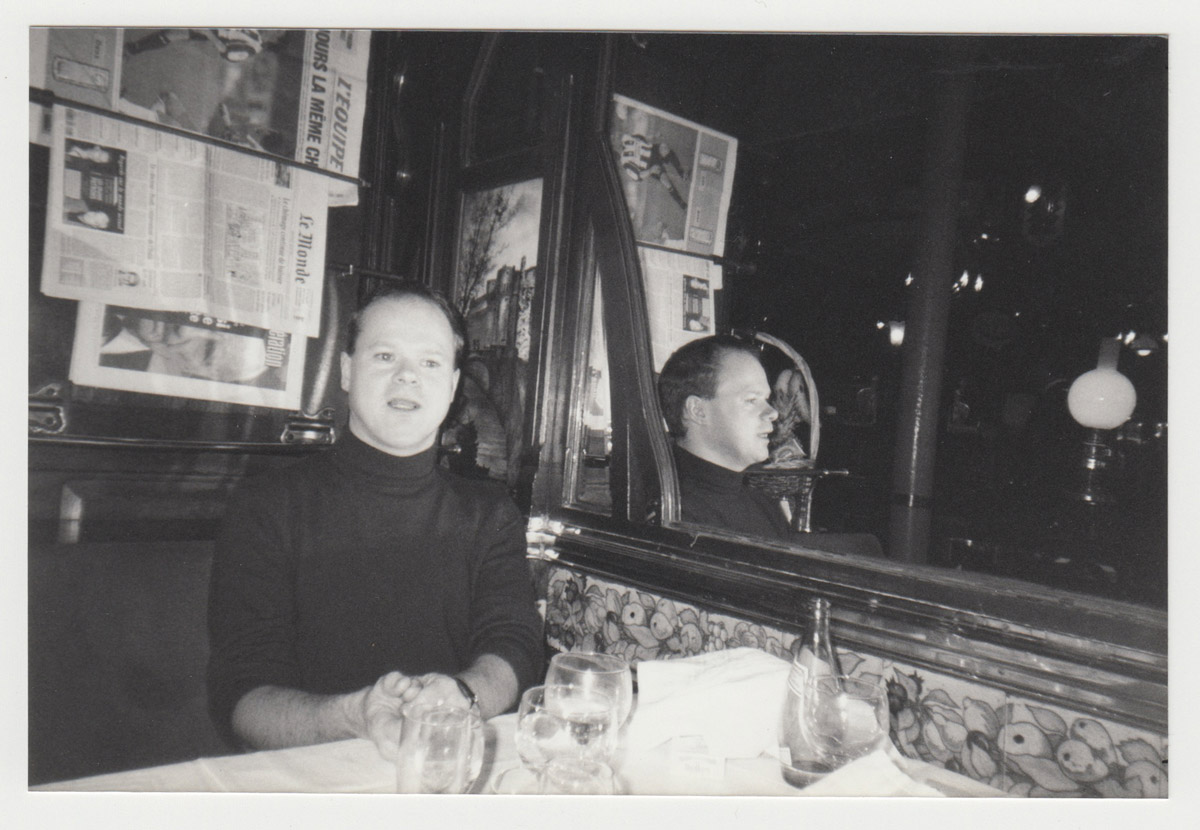
The artist at Brasserie Vagenende, Boulevard St Michel, Paris France, 1998
b1998.4
